CHANGSOK.
“Changsok” refers to the metal decoration used on Korean furniture. These metal fixtures served both utilitarian and decorative purposes, being crafted from materials like cast iron, copper, tin, nickel, and white brass.
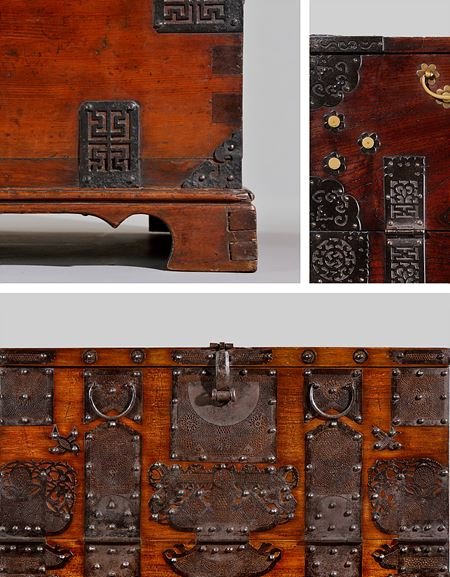
The white brass alloy, which includes tin and sometimes nickel in addition to the conventional copper and zinc found in yellow brass, may also contain lead. The exact color varies based on the proportions of these principal ingredients. Copper is abundant across the Korean peninsula, while tin is primarily mined in the Sokcho city area on the east-central coast (Edward Reynolds Wright & Man Sill Pai, “KOREAN FURNITURE, Elegance & Tradition”).
These metal decorations come in various shapes and designs, tailored to the type and size of the chest. They play a dual role in strengthening joints and compensating for wood shrinkage or expansion, with the additional note that, on old pieces, they were all handmade.
During the early period (18th century to mid-19th century), metal hinge patterns on furniture were sparse, simple, and modest. Metalwork served essential functions in a straightforward form until the early 19th century, with the emphasis shifting to the decorative aspect as it was passed down to later generations.
By the end of the 19th century, more ornate types of metalwork emerged, with many decorative motifs drawing inspiration from Chinese philosophy.
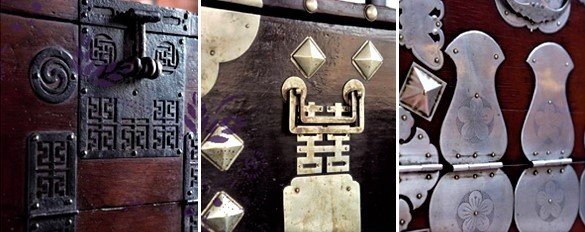
In the early 20th century, various new techniques, including engraving, embossing, and incising, were employed to enhance the decoration of plates.
On Bandaji, with the exception of some pieces from the northern part of Korea, such as Pyongyang and Gaesong, which were adorned with brass plates, most of the metalwork was executed using rough iron. The same iron metalwork was applied to various kitchen chests or coin chests to a lesser extent.
Yellow and white brass metalwork found its place on other types of furniture, such as “Jang” (Morijang) or headside chests, (Ich’ung Jang) or two-level chests, (Samch’ung Jang) or three-level chests. For “Uigori Jang“, also known as a wardrobe, a design specific to the 20th century, yellow or white brass was commonly used. The same can be said for small boxes designed to store documents, mirror boxes, shelves, and document chests.
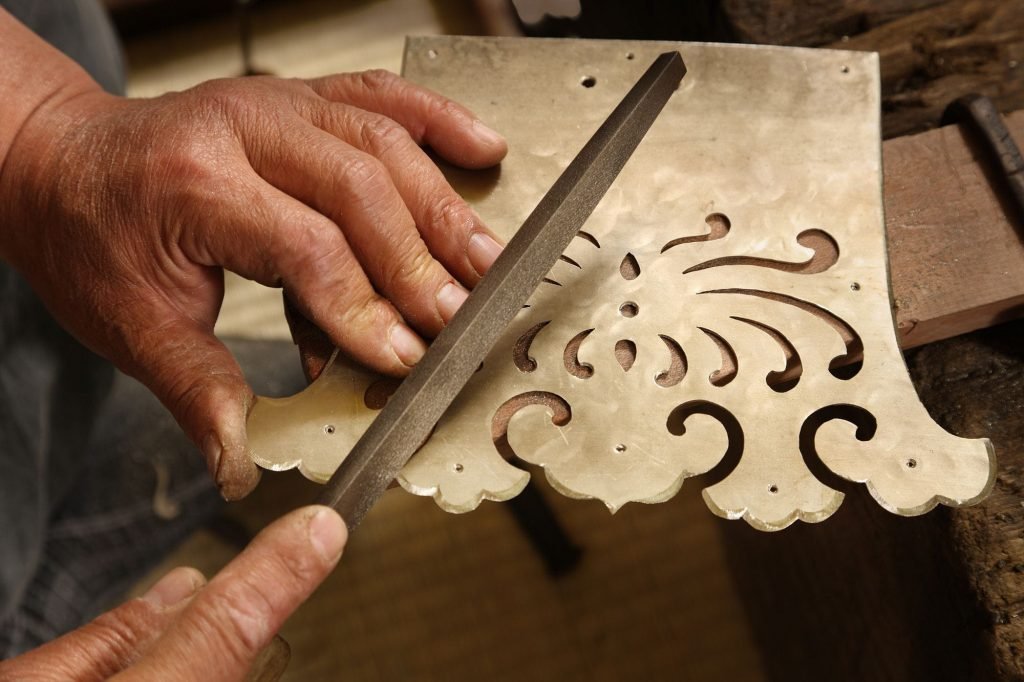

Changes in the use of materials from the Joseon period to the present day.
An analysis of antique pieces reveals that a significant portion of Korean furniture featured blackened iron hinges. This is especially true for bandaji, book chests, kitchen chests…
As mentioned earlier, clothing chests from the 19th century could, however, be adorned with metal parts in yellow or white brass.
Our research unveiled that, during that era, the more costly yellow brass was employed in furniture crafted for the upper classes. In contrast, white brass was more prevalent, evident in its widespread use on furniture in the northern provinces of the peninsula.
In the 20th century, with the emergence of an export market to the West, the numerous reproductions primarily utilized yellow brass hinges.
The transition from white brass to yellow brass in the metalwork of Korean reproduction furniture likely stems from several contributing factors. Firstly, aesthetics: the rich, warm tone of yellow brass has become more synonymous with quality and tradition, rendering it more desirable in reproduction pieces that often aim to evoke a sense of history or classic style. Secondly, the composition of the alloys: white brass, higher in zinc, is more brittle and challenging to work with than yellow brass. Although it may have been more economical in the past, advances in metalworking technology and the globalization of resources have likely minimized the cost differences. Lastly, health and environmental concerns: white brass often contains lead, which has been phased out of many products due to health risks. In contrast, yellow brass is typically lead-free, making it safer and more environmentally friendly. Therefore, while white brass may have been the economical choice in the past, yellow brass has become the standard for various reasons today.
LOCK PLATES
Lock plates are flat metal mounts on which a lock and lock receptacles are positioned. They serve to shield the surface of furniture from direct contact with locks.
Situated at the front top of the furniture, they were a significant feature on bandaji. In Korean, they are referred to as “Appat’ang”. Due to their prominently visible placement, they also came in a variety of shapes.
CLOUD PATTERN

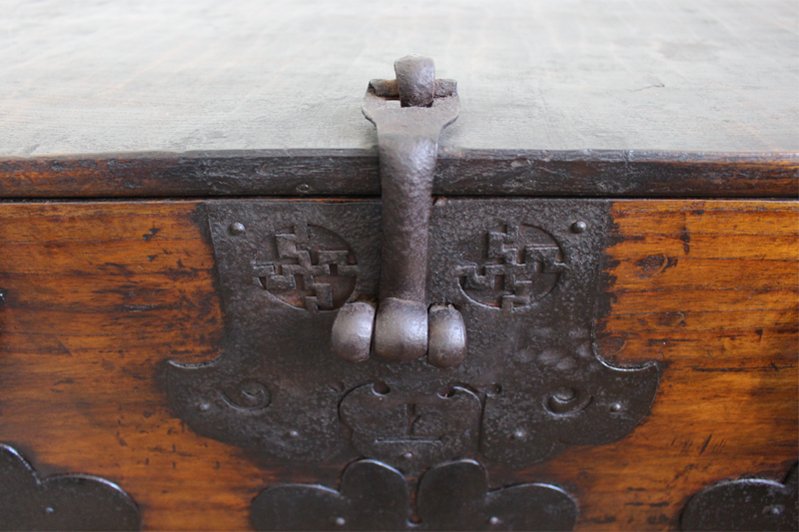
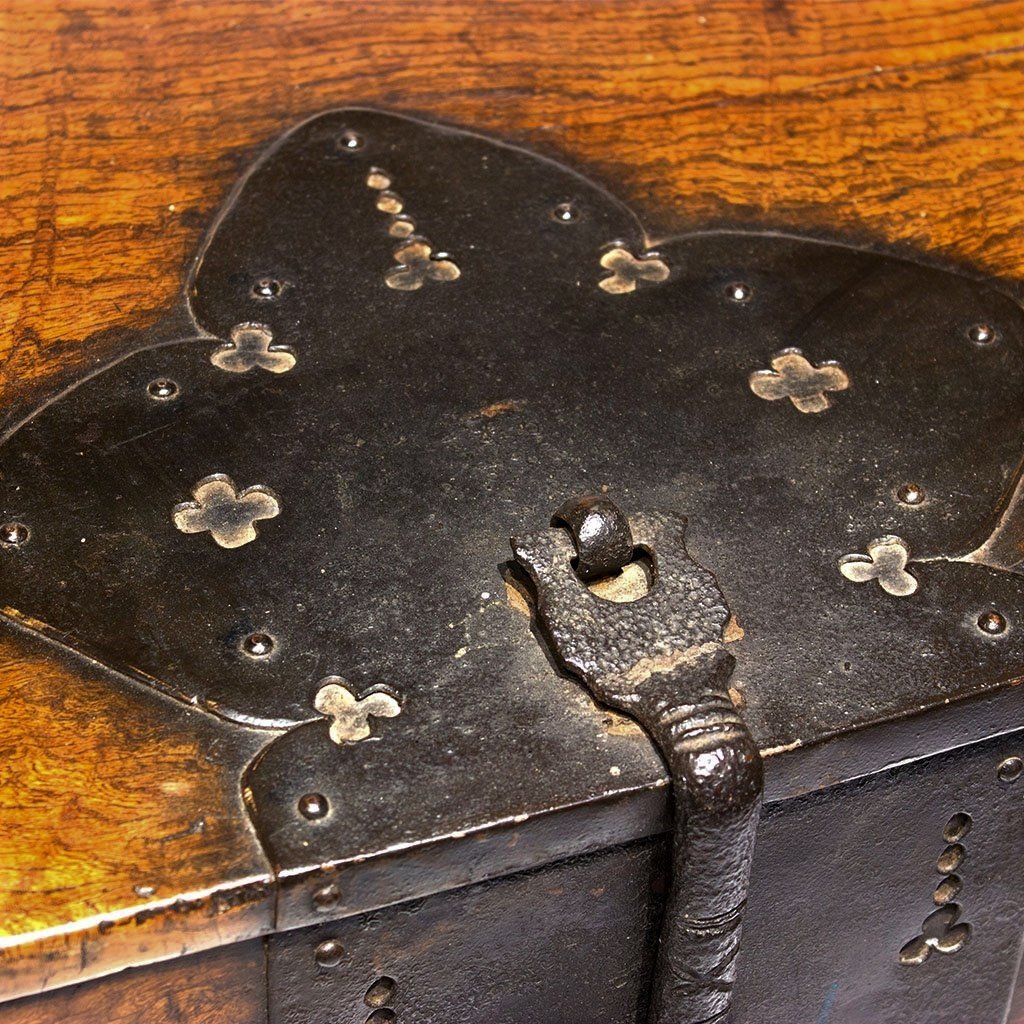
Flower design. Iron

Cloud pattern with engraved “Manja” (卍). & flower motifs.
Small house at the bottom

Cloud pattern with engraved “Manja” (卍) & cloud motifs.
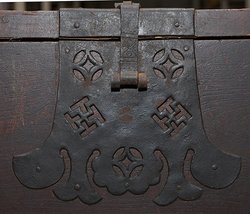
Cloud pattern with engraved “Manja” (卍) & flower motifs
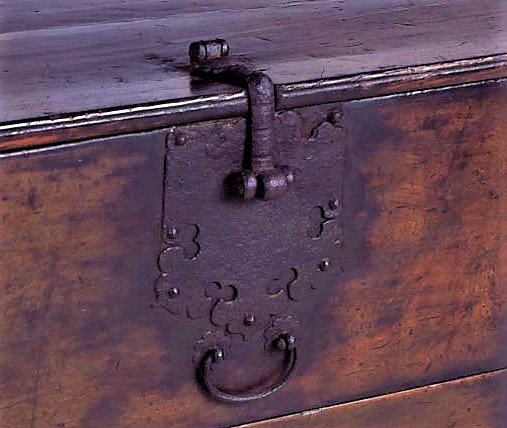

SQUARE PATTERN
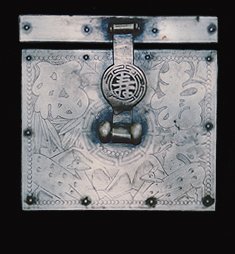
Pyongyang Bandaji, White brass.
Incised deers with bamboo motifs & Chinese characters.
These two photos illustrates lock plates made of white brass and mainly used on pieces from the northern part of the peninsula, especially Pyongyang Bandaji from Pyongan Do province.

Pyongyang Bandaji, White brass.
Incised deers, bamboo, crane & pine motifs. Typical “fish” lock commonly found on Pyongyang Bandaji.

Pyongan province. White brass metalwork covers usually the entire front of the chests.
Square pattern lock plate are widely used.
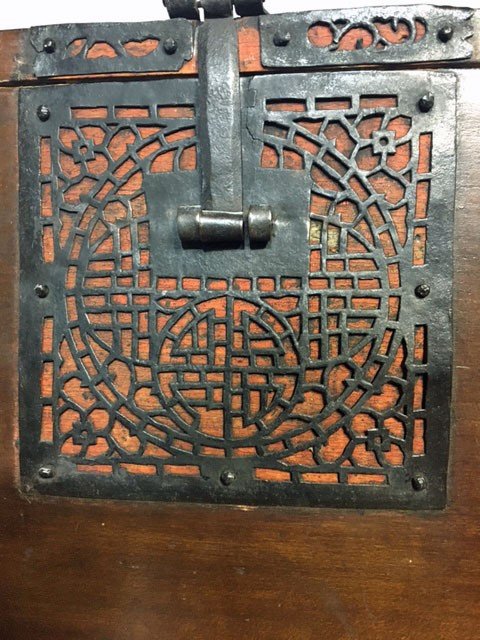
” Sung Sun I ” Bandaji from the northern province.
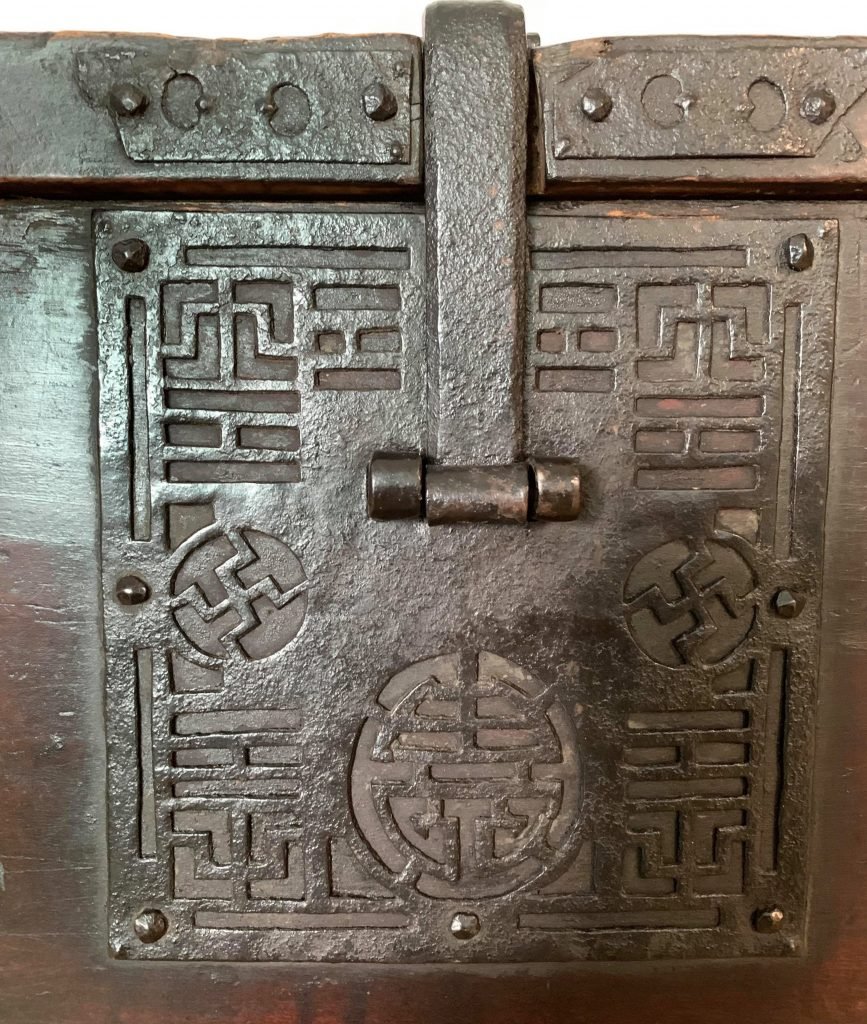
” Sung Sun I ” Bandaji.
It display some stylized Chinese characters, “Manja” (卍) & trigram motifs.
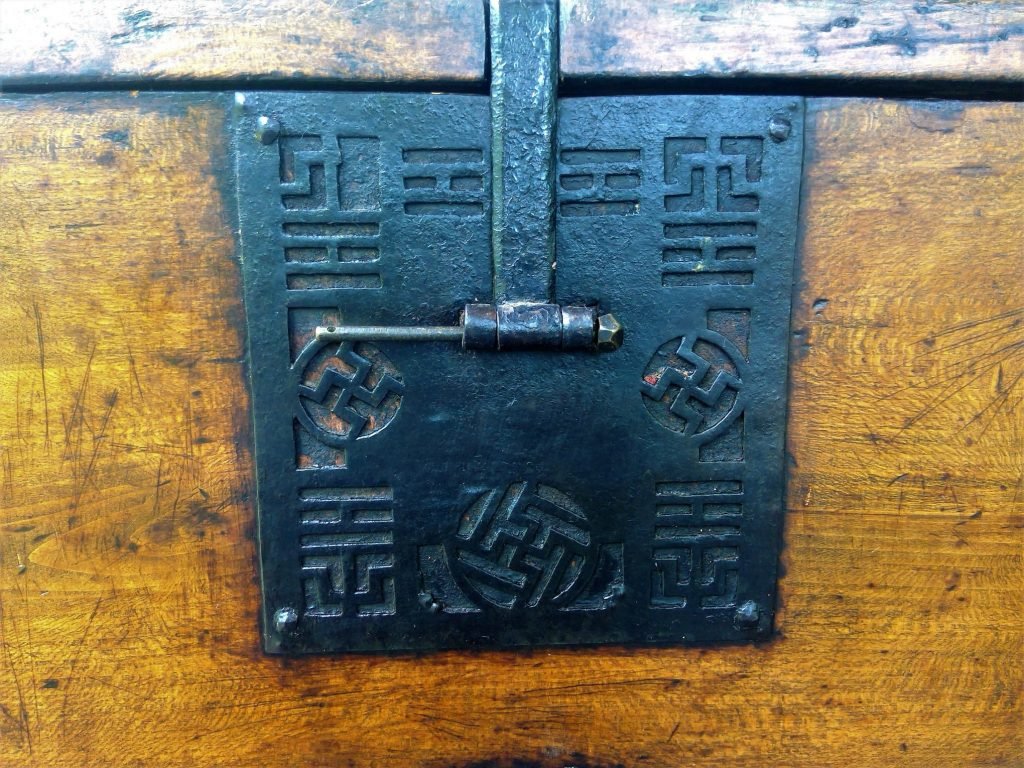
Engraved “Manja” (卍) and trigram motifs.

White brass lock plate on Morijang

ROUND PATTERN

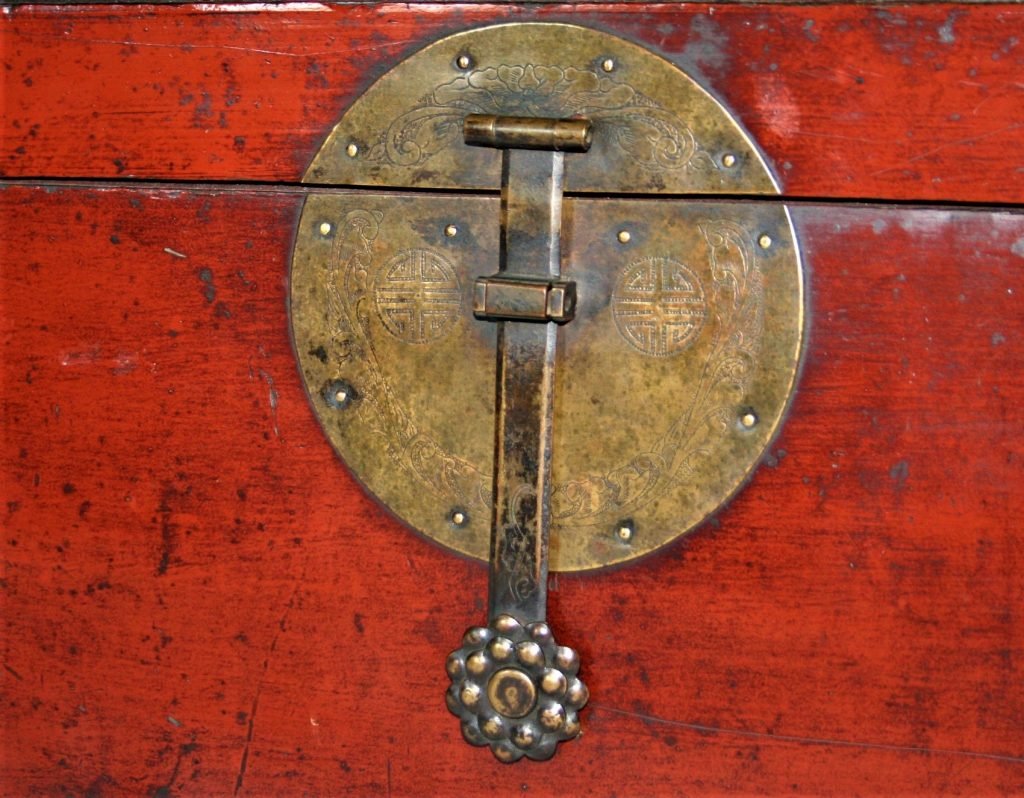
on a red lacquer wedding box.
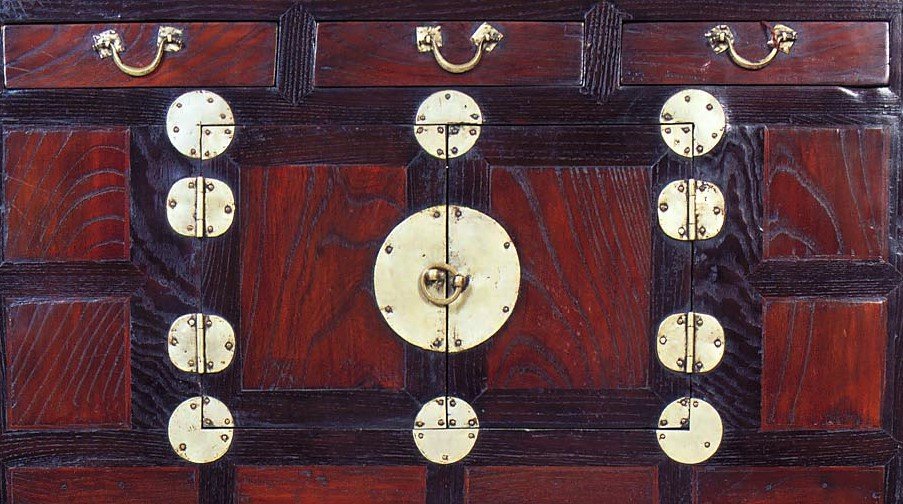
White brass on Nong
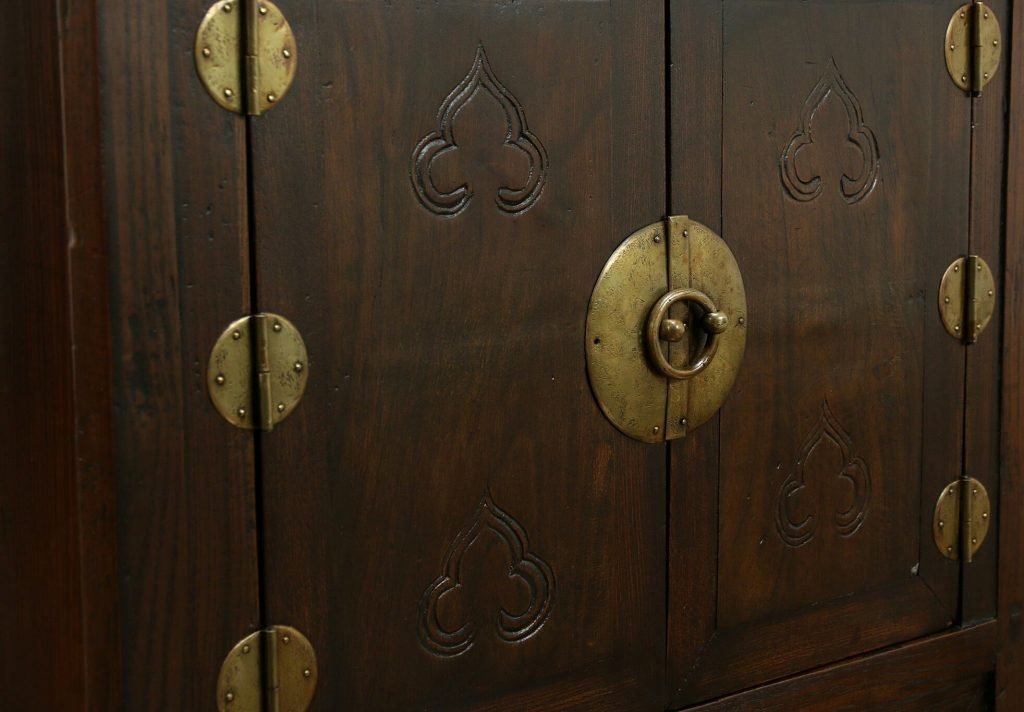
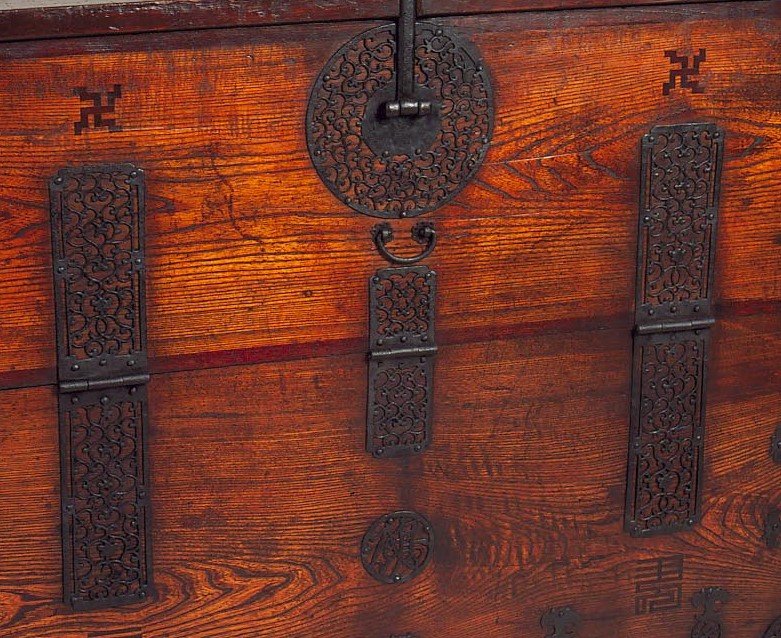

FLOWER PATTERN
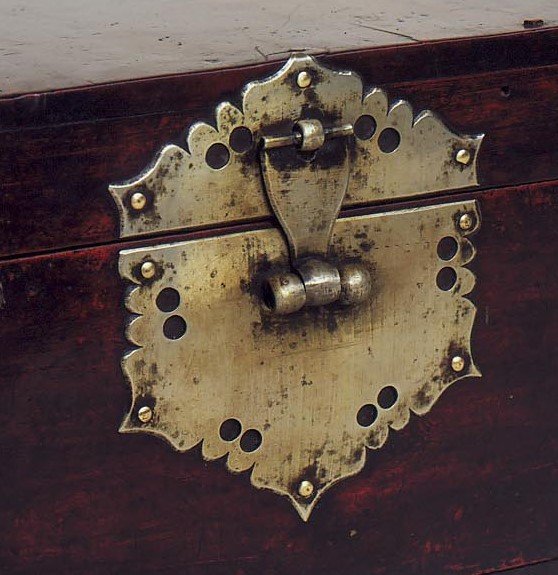
Lock plate on a small wooden box.
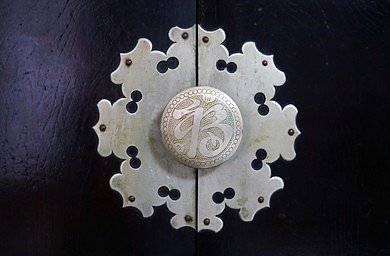
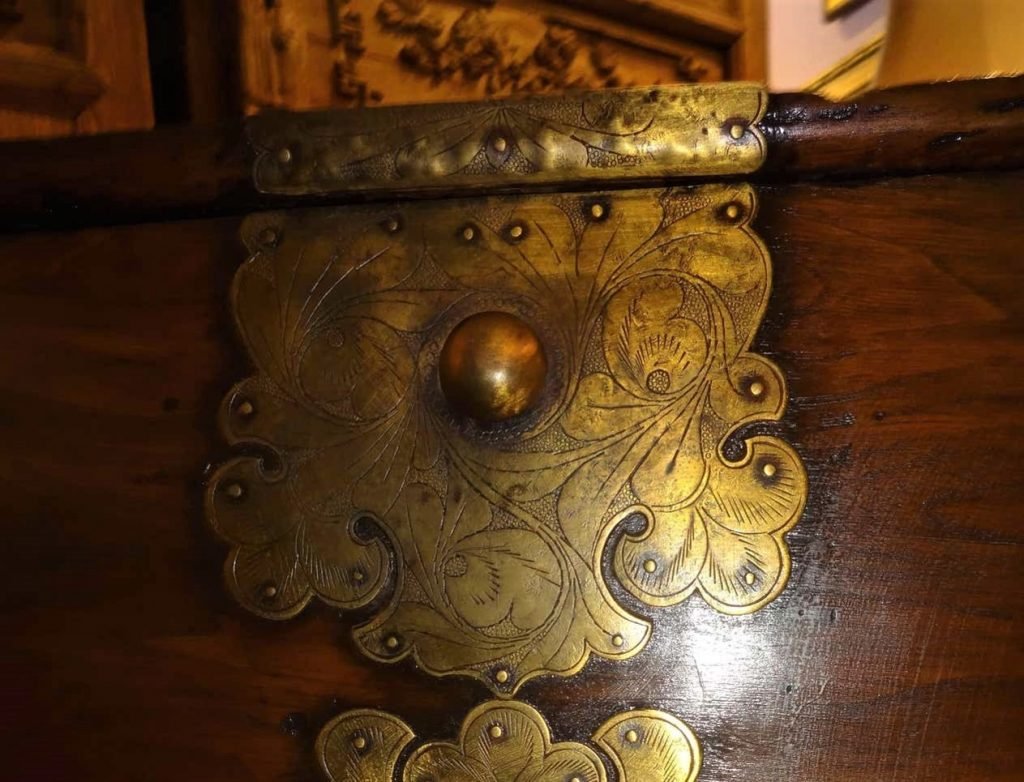
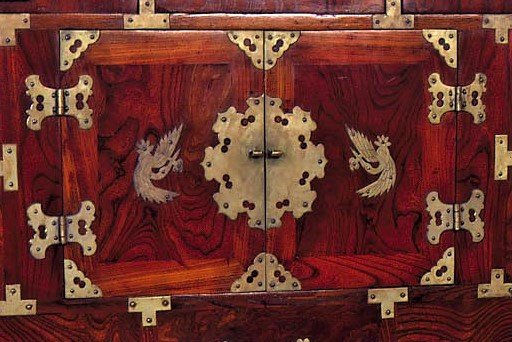
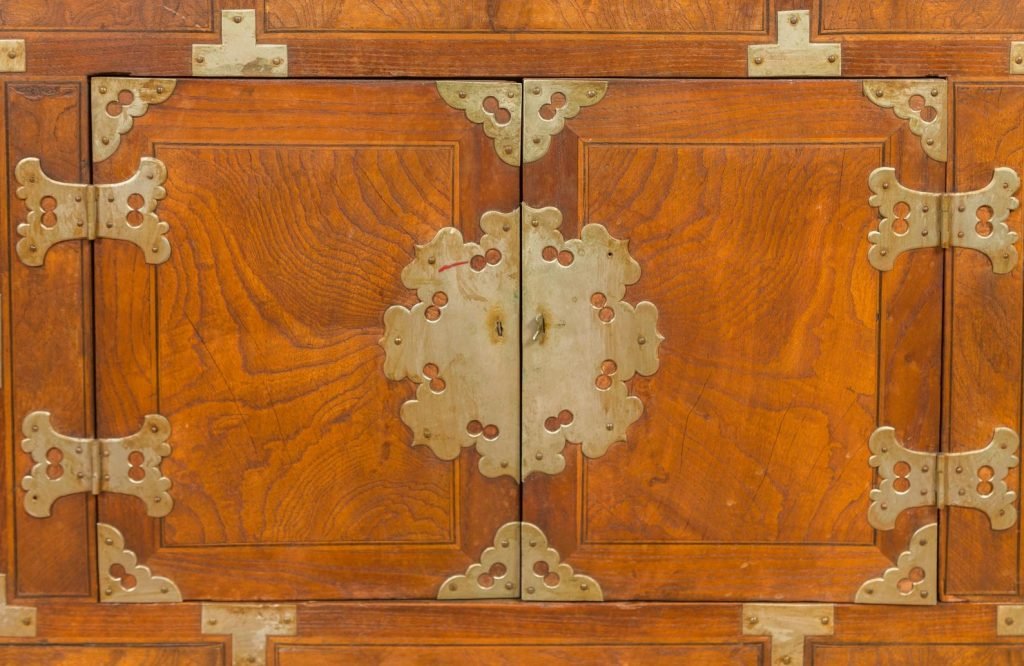

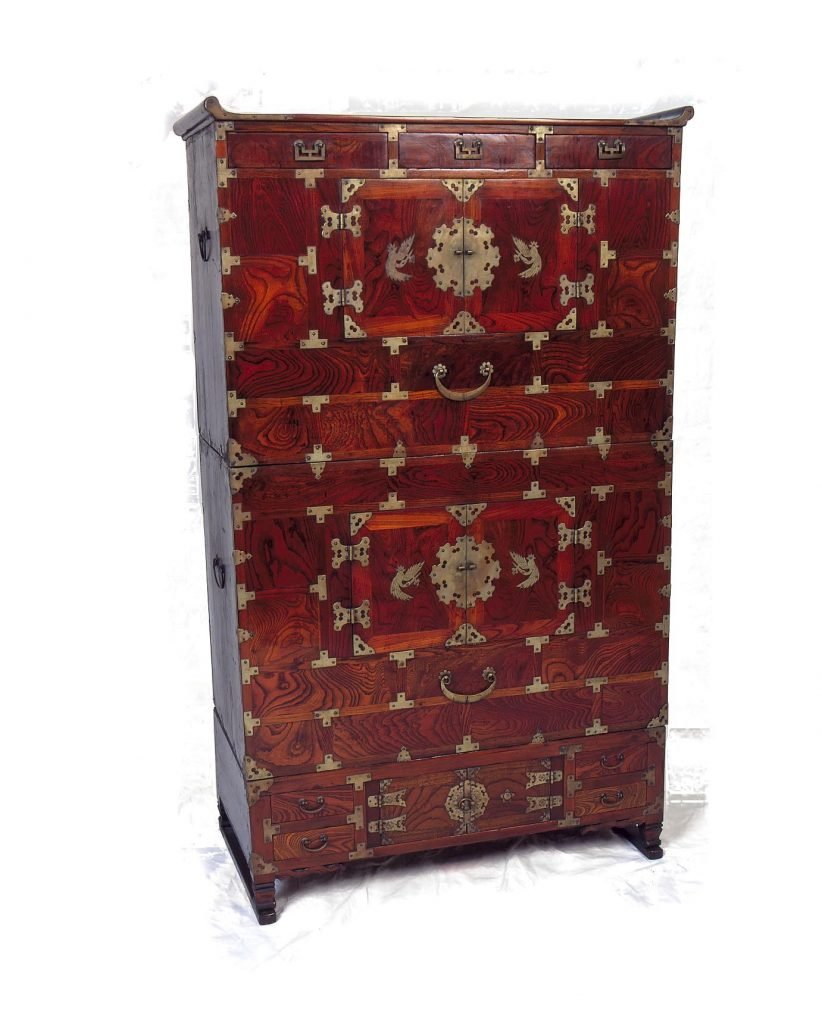
It was probably used to be part to a woman’s quarter
Flower, clouds, & birds (crane). Central lock plates with flower motifs.
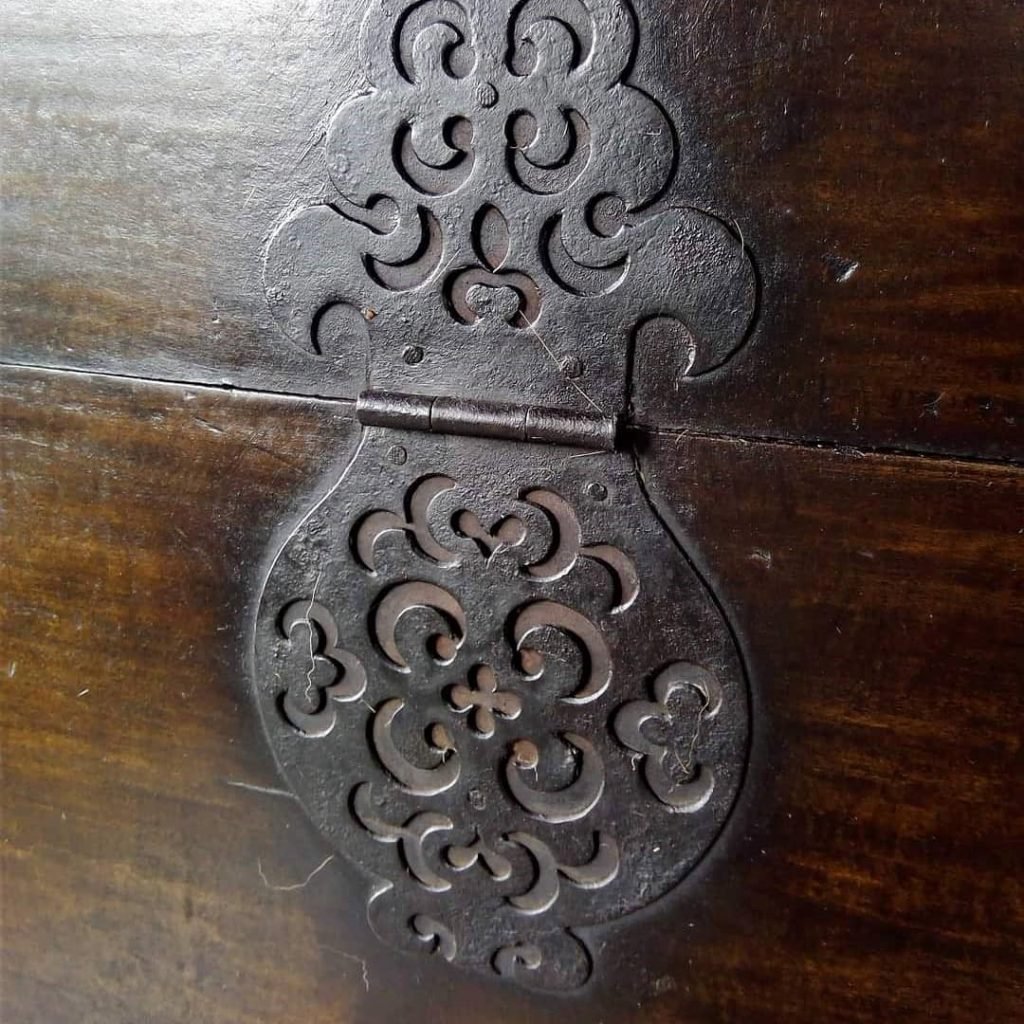
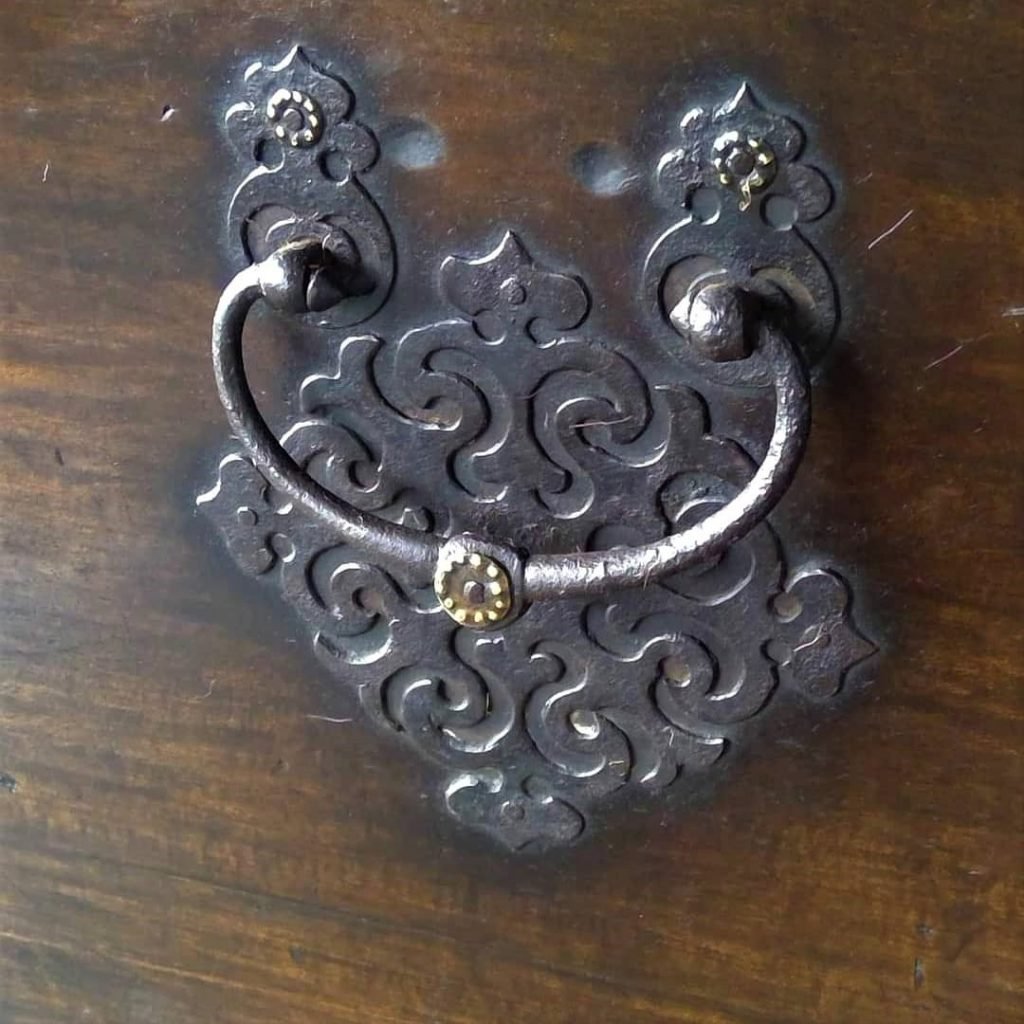
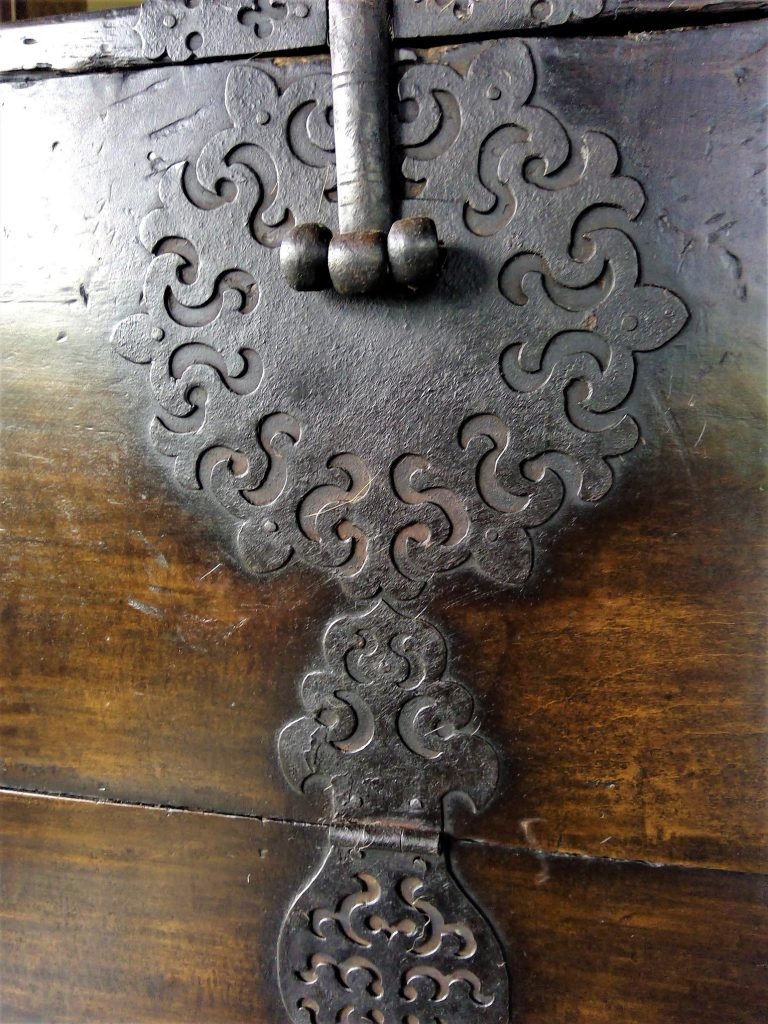
BUTTERFLY PATTERN
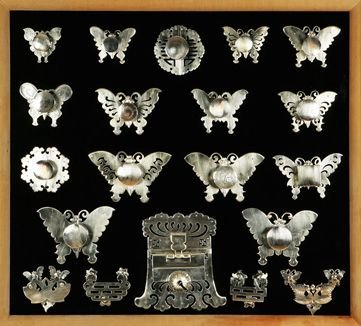
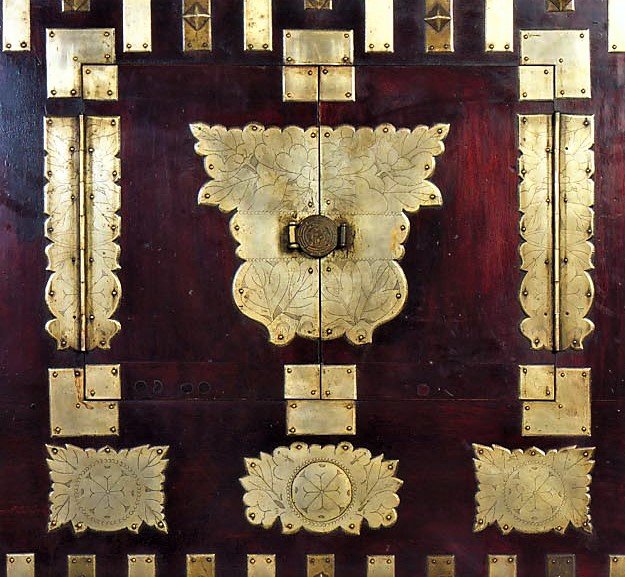

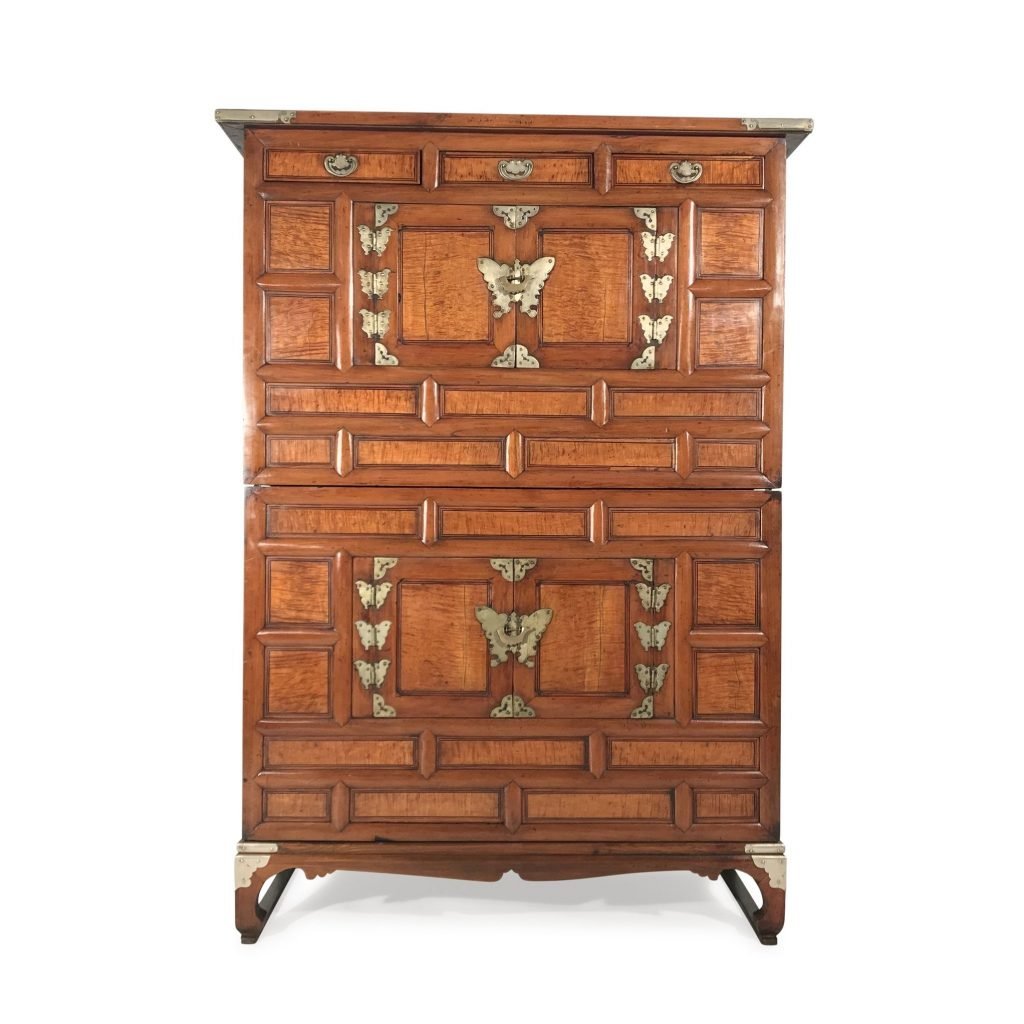
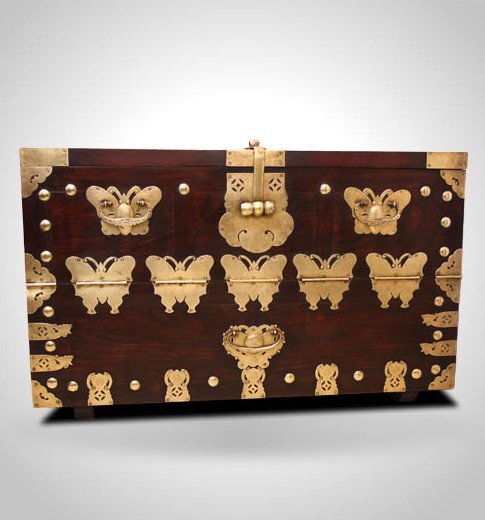
HINGES
Hinges are metal mounts used to attach doors to the body of furniture, allowing a door to open and close. In Korean, they are referred to as “Kyongch’op”. Depending on the region, they were made of iron, white, or yellow brass. Their designs provide information about the geographic origin of the Bandaji.

BELT HINGES

White brass with incised auspicious motifs such as
Chinese characters, birds, bamboo, pine trees.
Popular on Bandaji from the northern provinces.
Pyongyang and Gaesong.



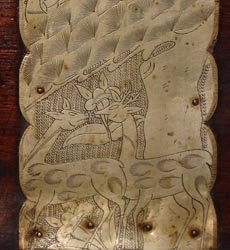

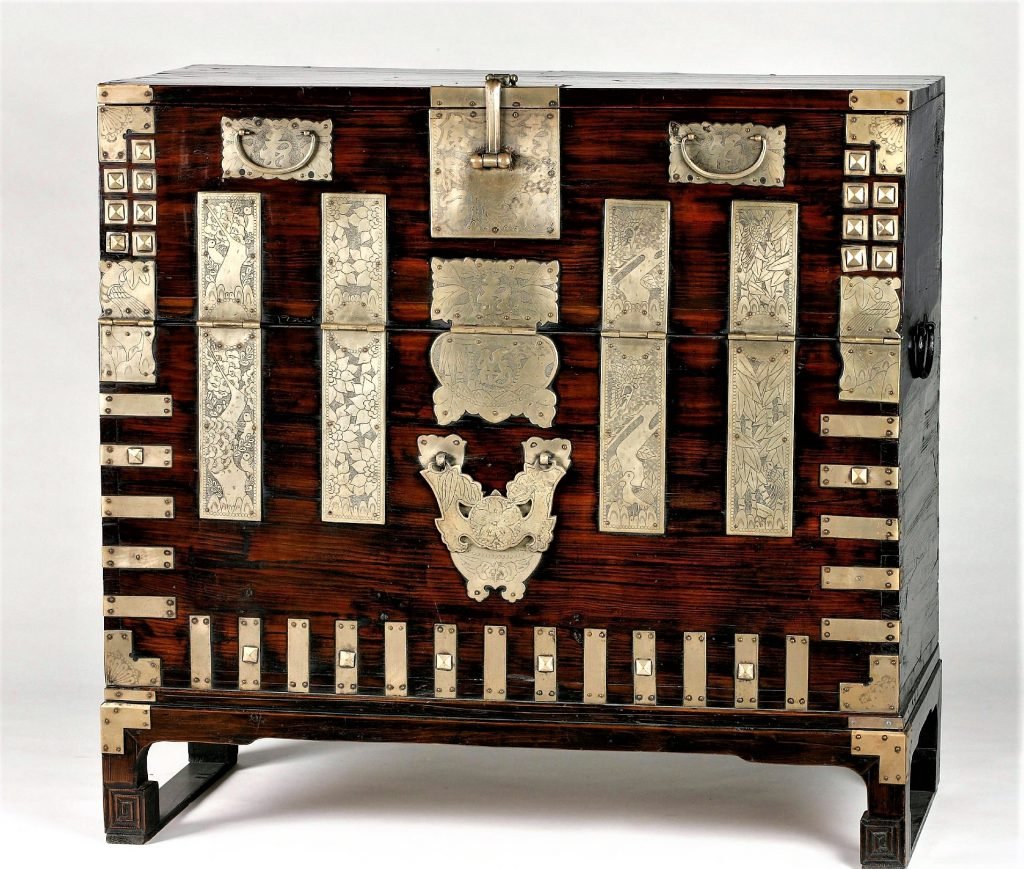
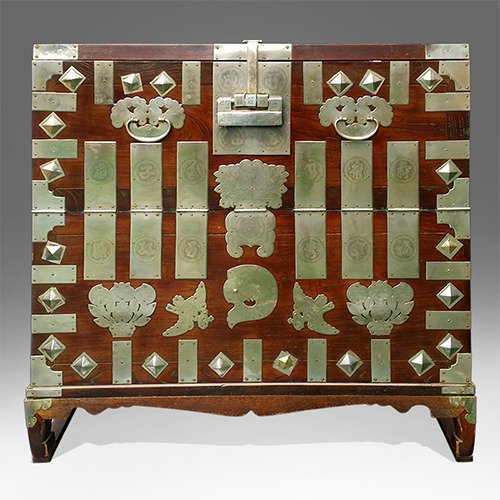
Large six belt hinges with incised Chinese characters.

Long rectangular plates. Iron. Engraved geometrical motifs.
Those were commonly applied on Bandaji from the northern provinces, Sung Sun I style as well as pieces from Gyeonggi Do province & Gangwha island.
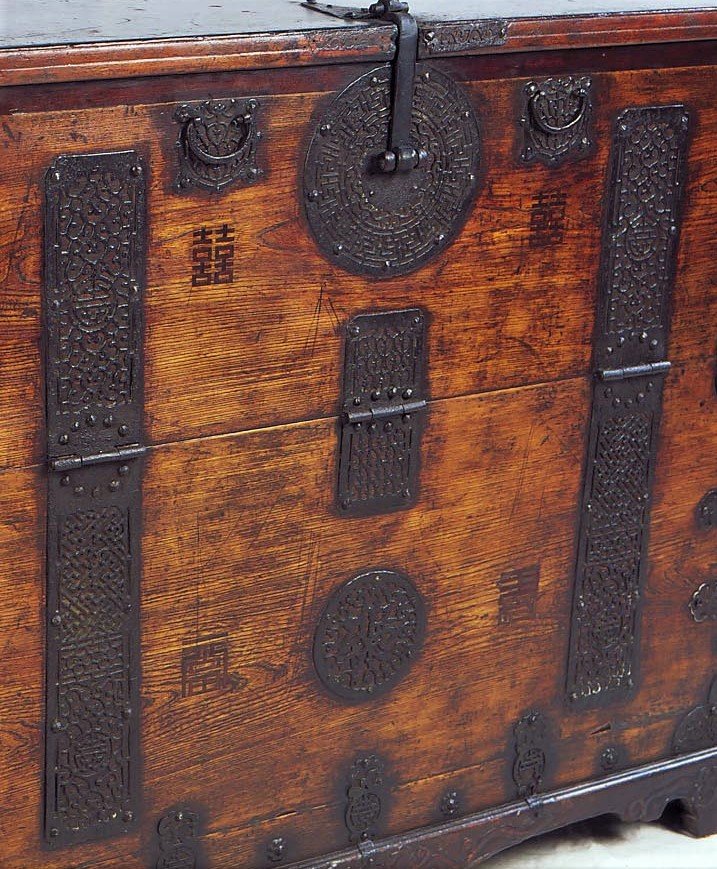
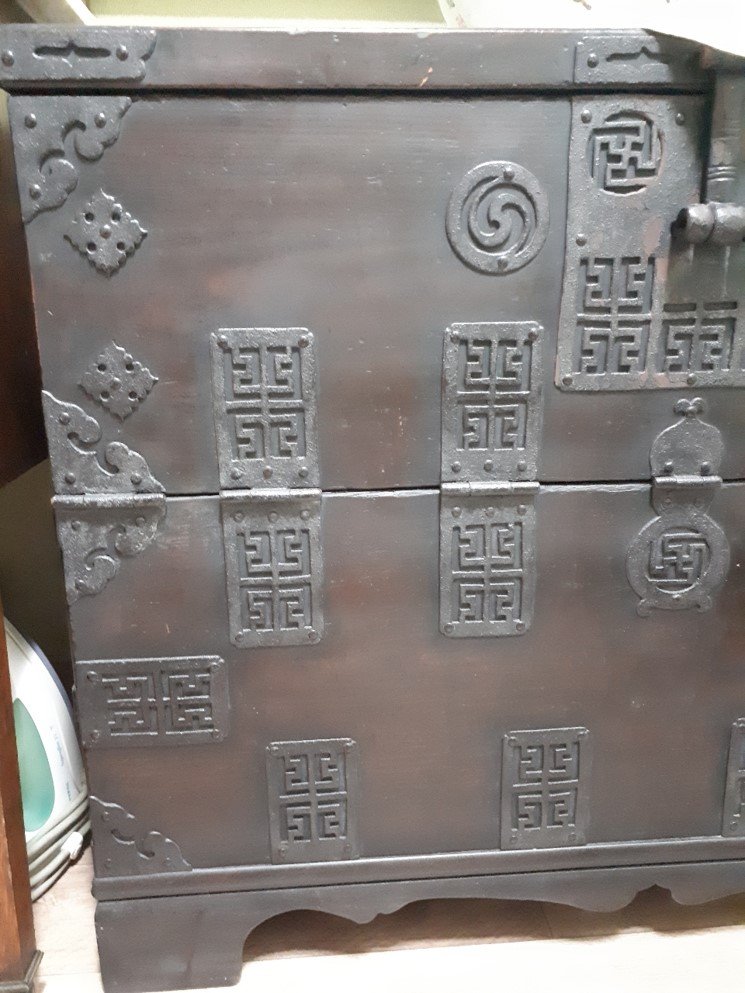
a Gangwha Bandaji
On the “Sung Sun I” Bandaji, the beauty of the metalwork is showcased through its intricate geometric patterns with elaborate openwork. It employs a technique of carving out patterns by chiseling each piece (iron is hardened by heating it in a fire).
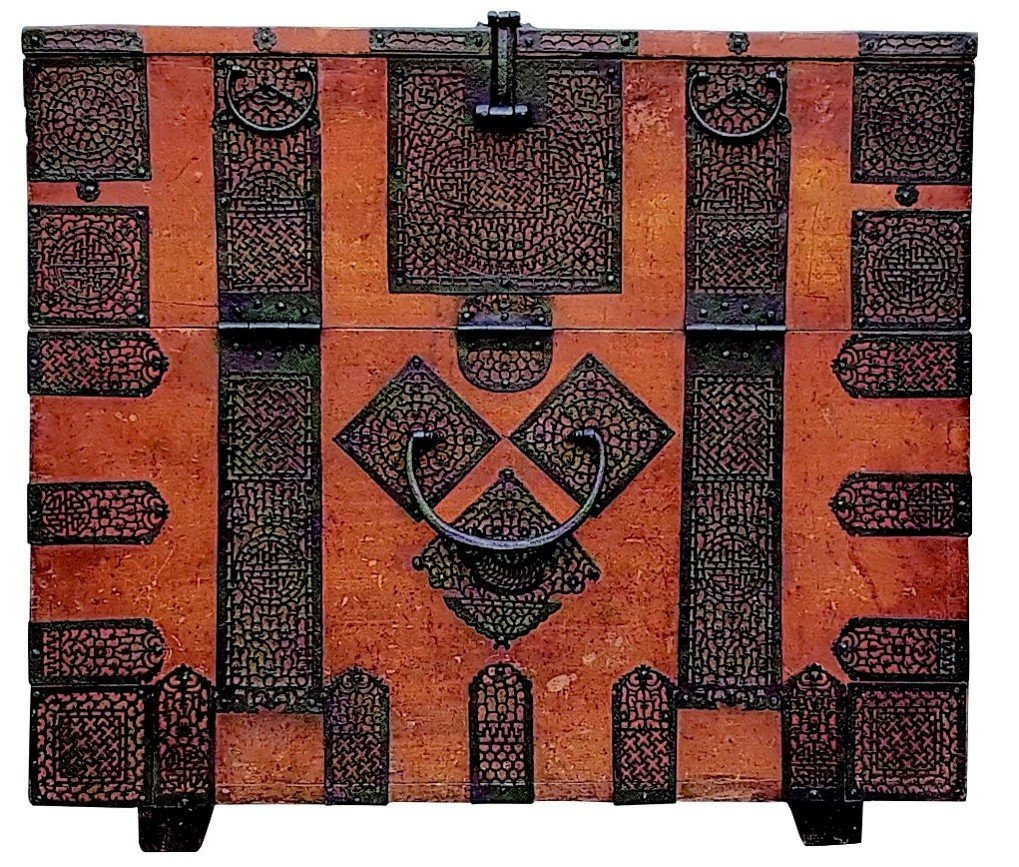
” Sung Sun I ” Bandaji from the northern province.
CLOUDS PATTERN HINGES

Also called “Cloud head”, they are widely
used on Jeju do and Jeolla do Bandaj. White brass was used on Jangs and iron on bandaji.


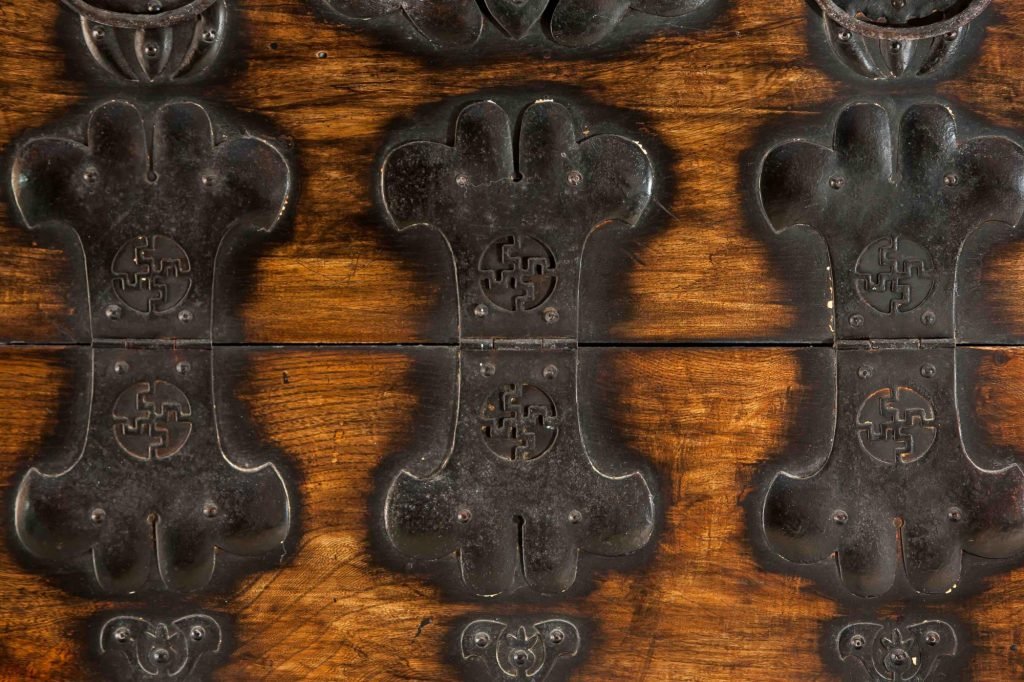
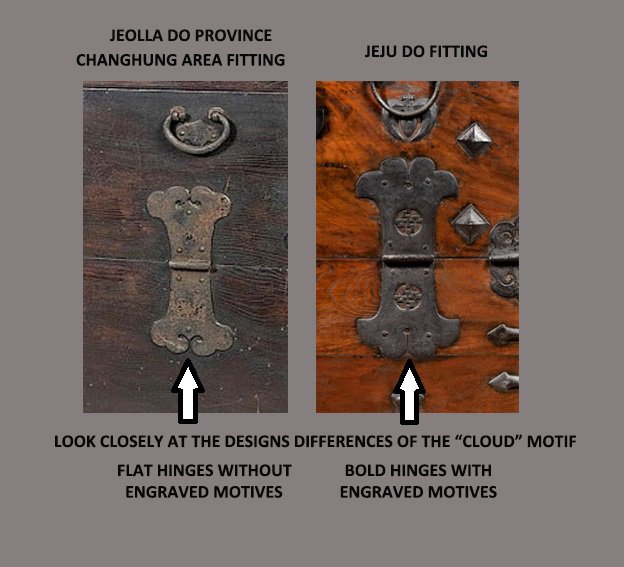

SQUARE PATTERN HINGES

engraved “Manja” (卍) motif.
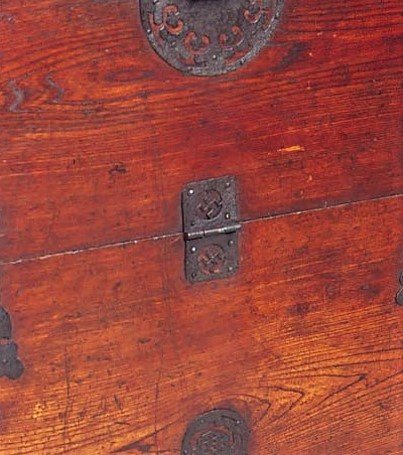
SWALLOWTAIL PATTERN
The Swallowtail pattern was highly popular throughout Korea.
White brass was utilized in the northern part of the peninsula, while iron was widely employed in Jeolla Do and Gangwon Do provinces.

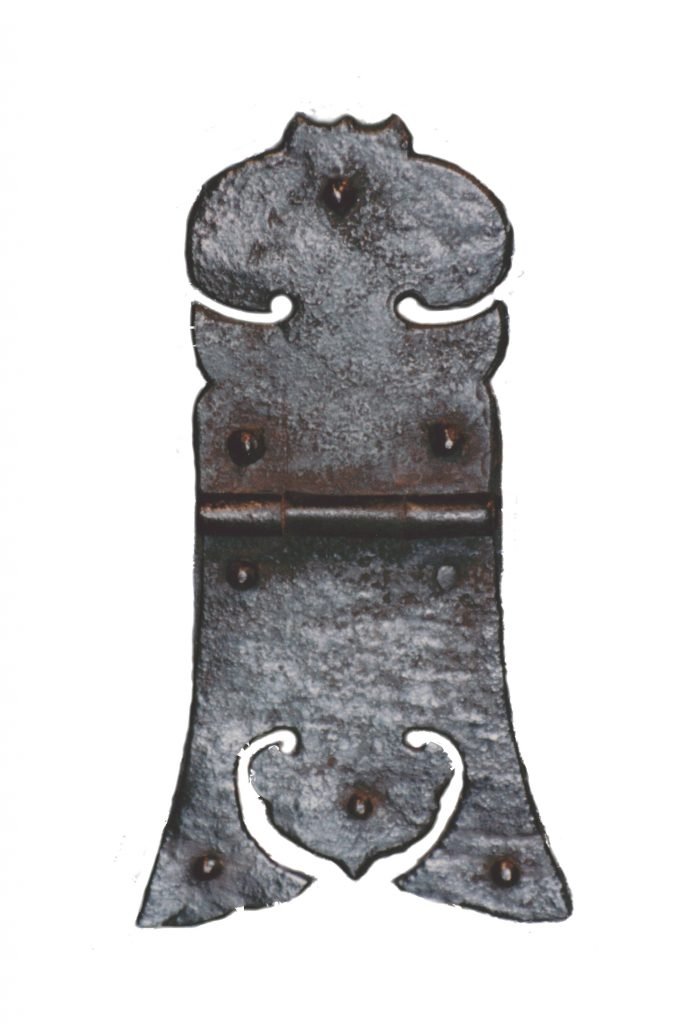
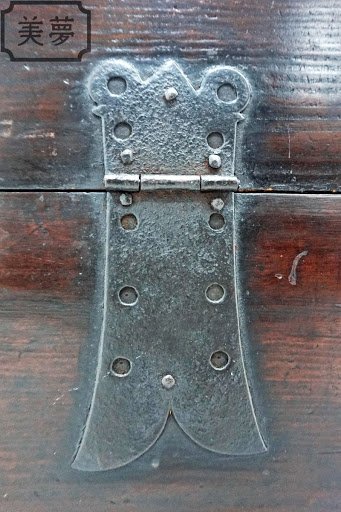
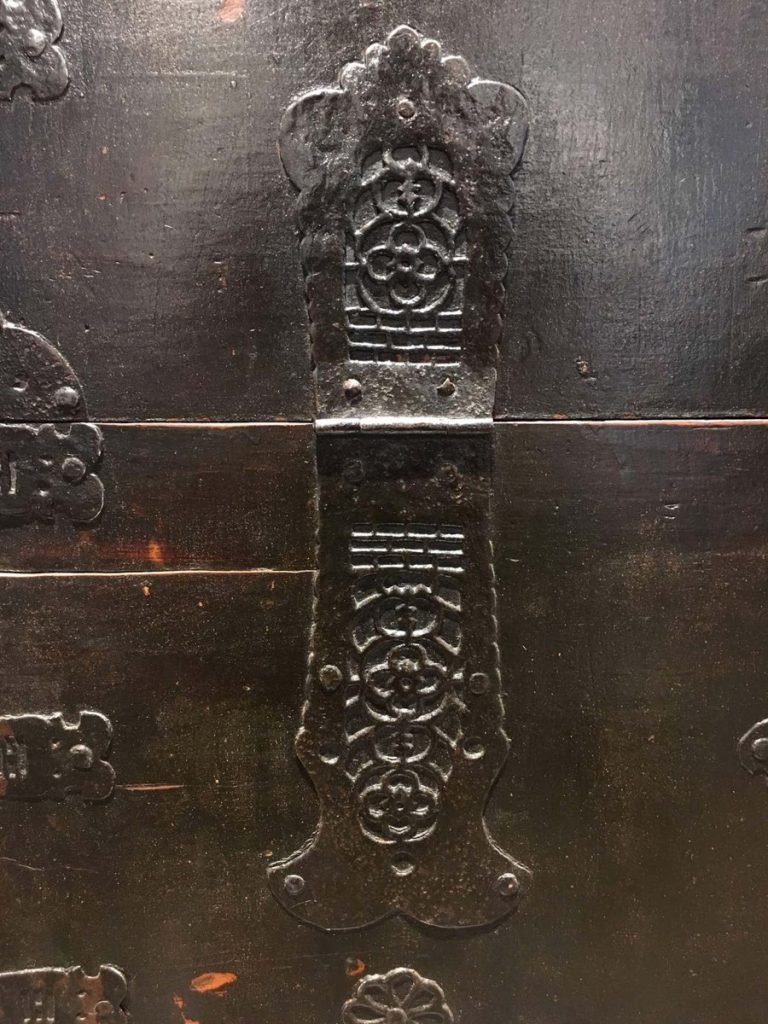
with flower motif on Gyeongsang Do Bandaji

with “Manja” (卍) motif on Gyeongsang Do Bandaji

Bandaji from Gangwon Do province.



GOURD OR VASE PATTERN
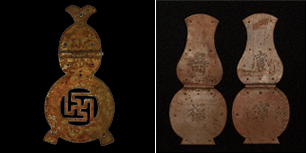
Engraved “Manja” motif (卍) (left). Incised Chinese characters (right).
This motif was used in Kyonggi area (white or yellow brass) as well as
In Gangwon Do province (iron)

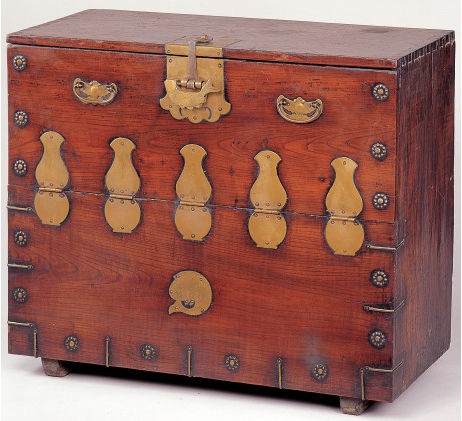
THE NAMDAEMUM GATE PATTERN
This pattern was primarily used on Bandaji from the northern part of the peninsula, which is now known as North Korea.
These plates could be made in brass for Pyongyang Bandaji or iron for Sung Sun I Bandaji.
The South Gate motif, known as “Namdaemun” (남대문) in Korean, is a common decorative element found in traditional Korean furniture and architecture. Namdaemun refers to the Great South Gate, one of the historical gates in Seoul, South Korea. It is an iconic symbol in Korean culture and is often incorporated into various forms of art and design, representing the gate as a symbol of protection.




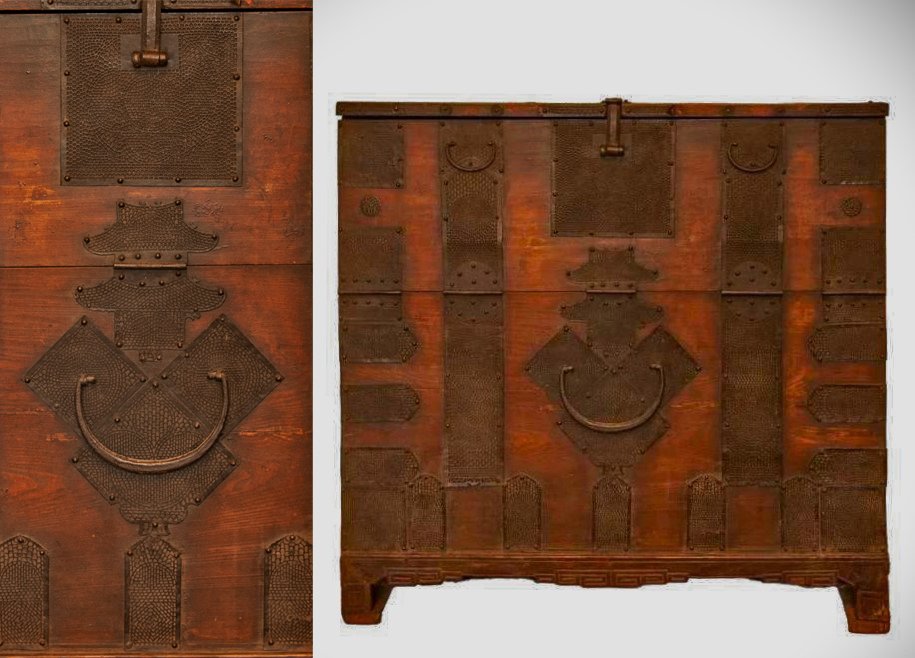
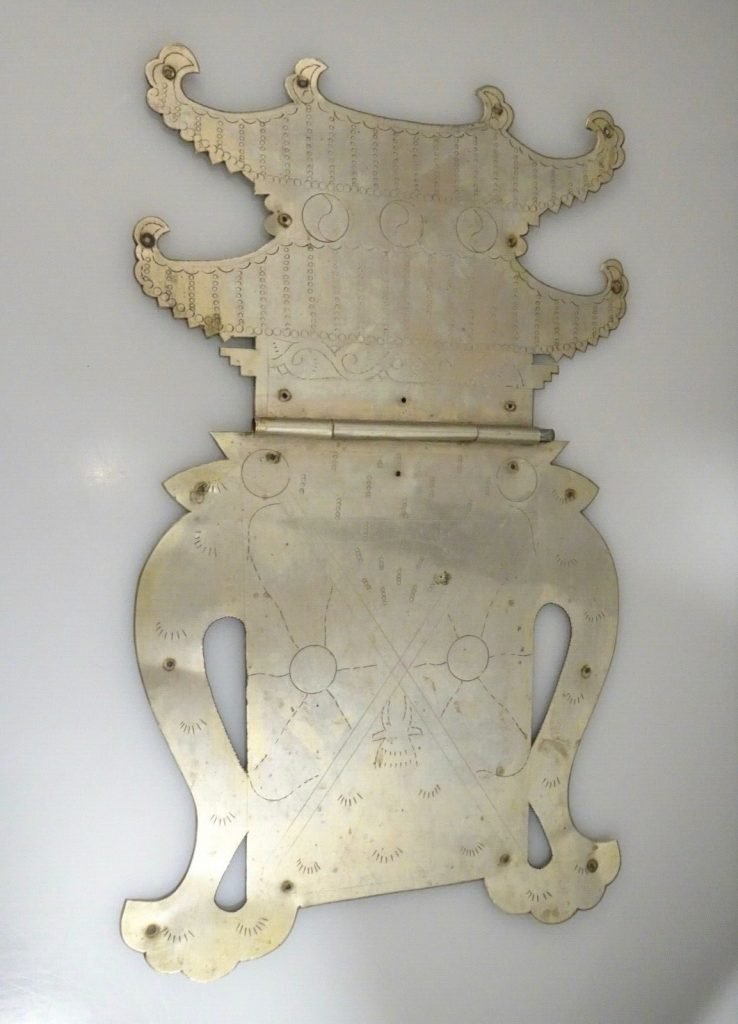
THE BUTTERFLY PATTERN (HINGES)


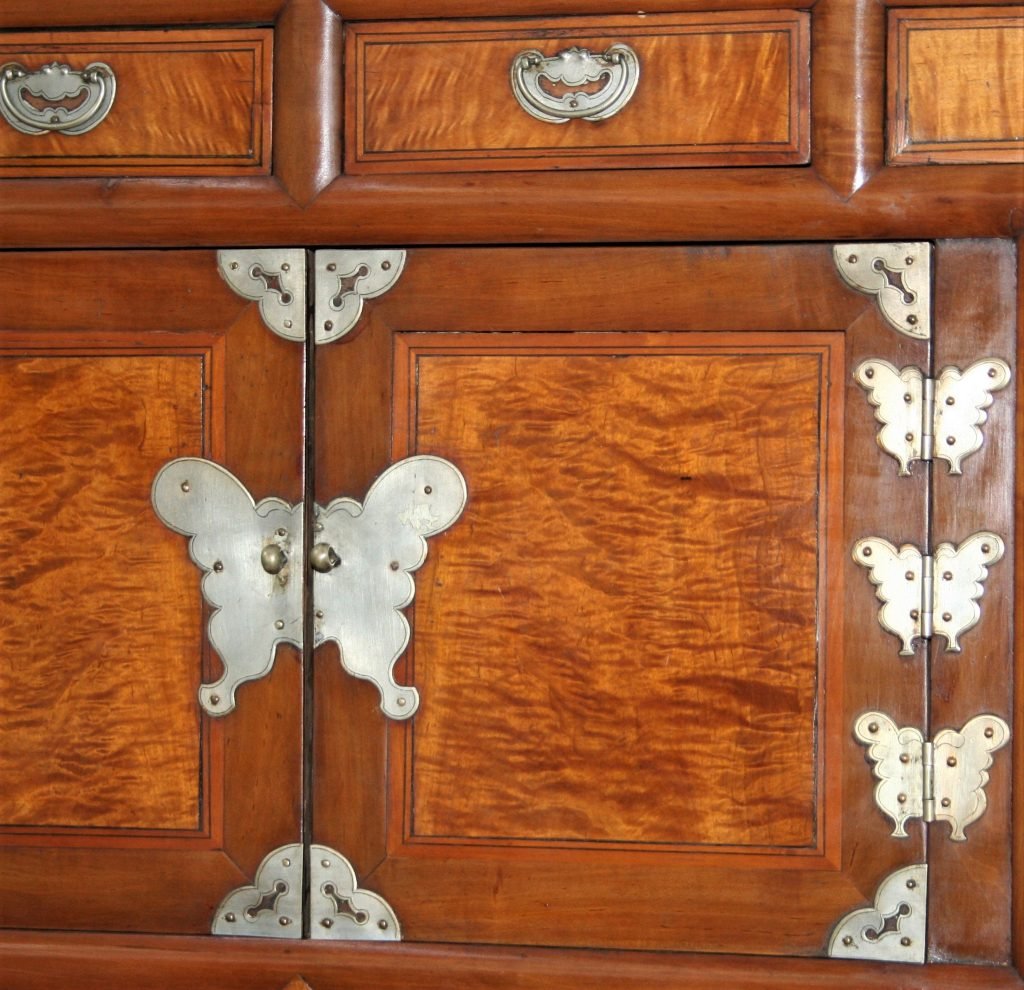
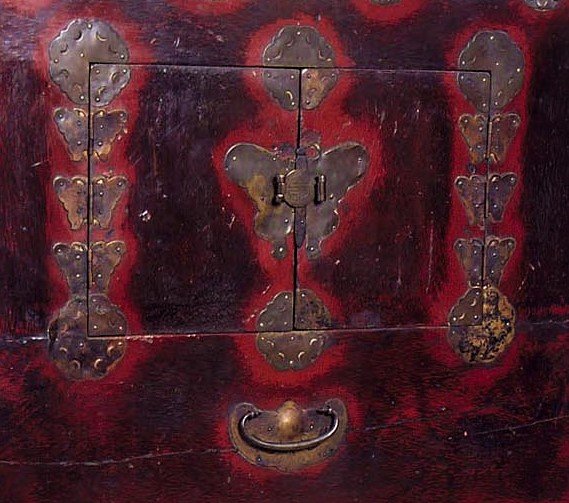
( photo left ) and
Nong ( photo above ).
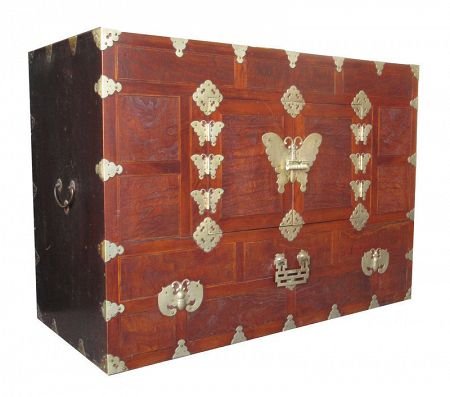
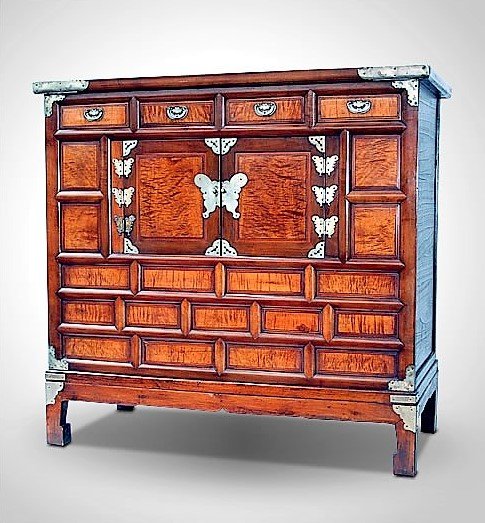
DOUBLE CABBAGE PATTERN

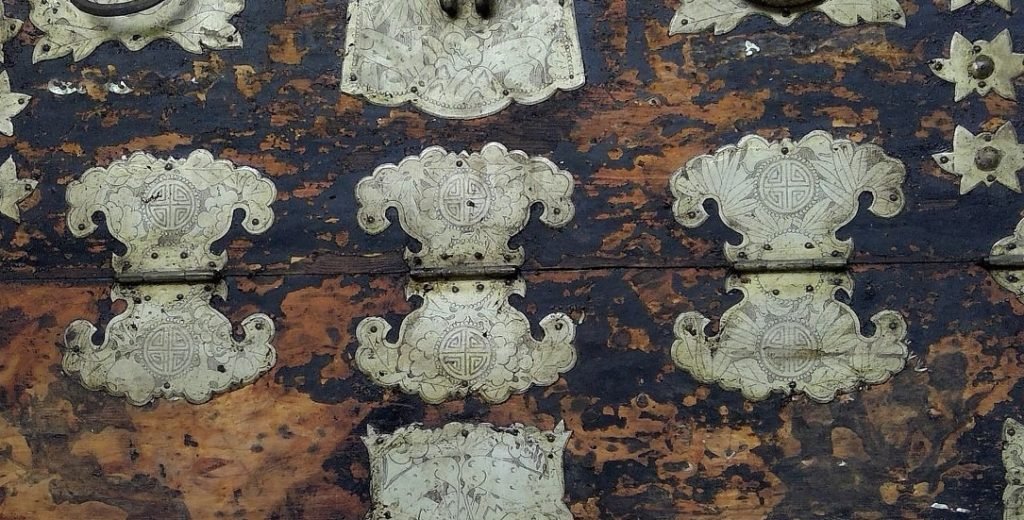
of the chest as fittings holding the opening panel.

( Northern style ).
HANDLES
Handles attached to the front panels or side panels on bandaji are used to lift furniture or to open drawers and doors.
In Korean they are called “Tul soe ”. The most common shapes used for handles included flower, bat and butterfly.

Gyeonggi Do Bandaji.
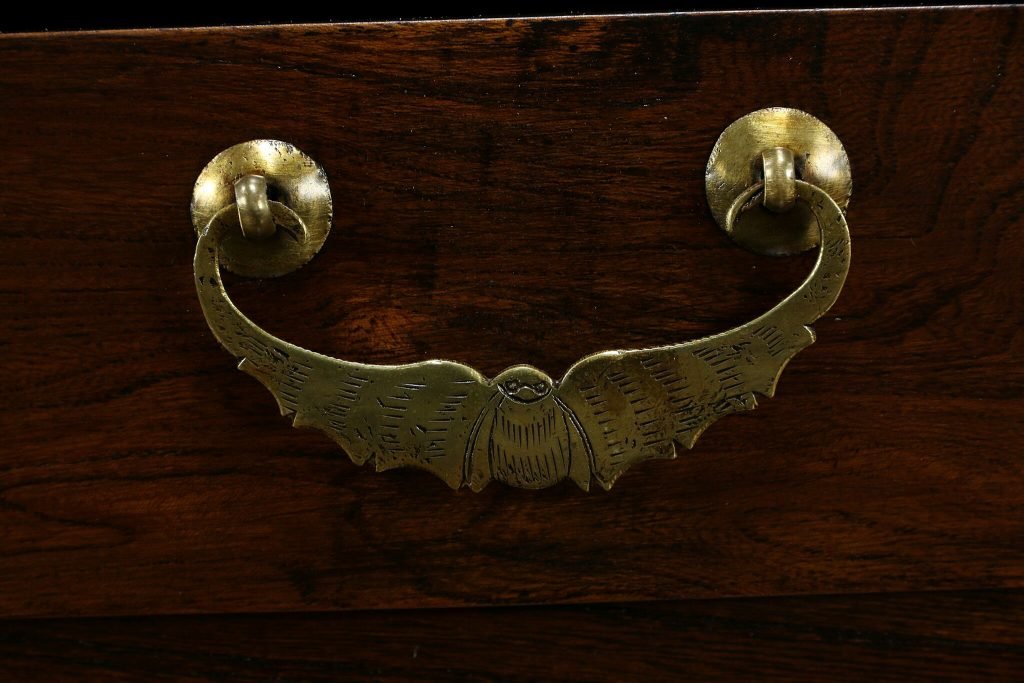

Pattern widely used on Gangwon Do
Bandaji


flower small plates
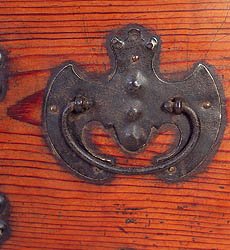
Gangwon Do Bandaji

Incised with bamboo, pine, and Chinese character.
This type of central handle was typical on Pyongyang Bandaji
JOINT & CORNER PLATES
Also called corner plates metal mount, they are attached on structurally jointed parts to reinforce the joint or just as a decorative purpose.
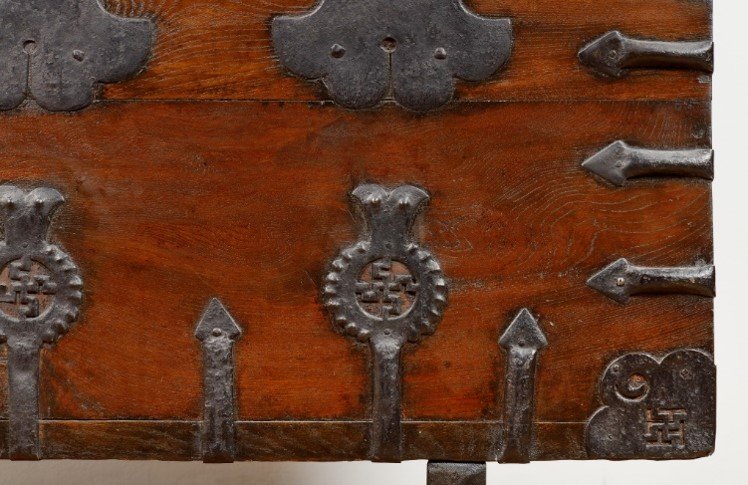
(卍) motif. Both photos of Jeju Do Bandaji
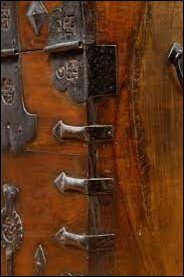

this Gangwon Do Bandaji.

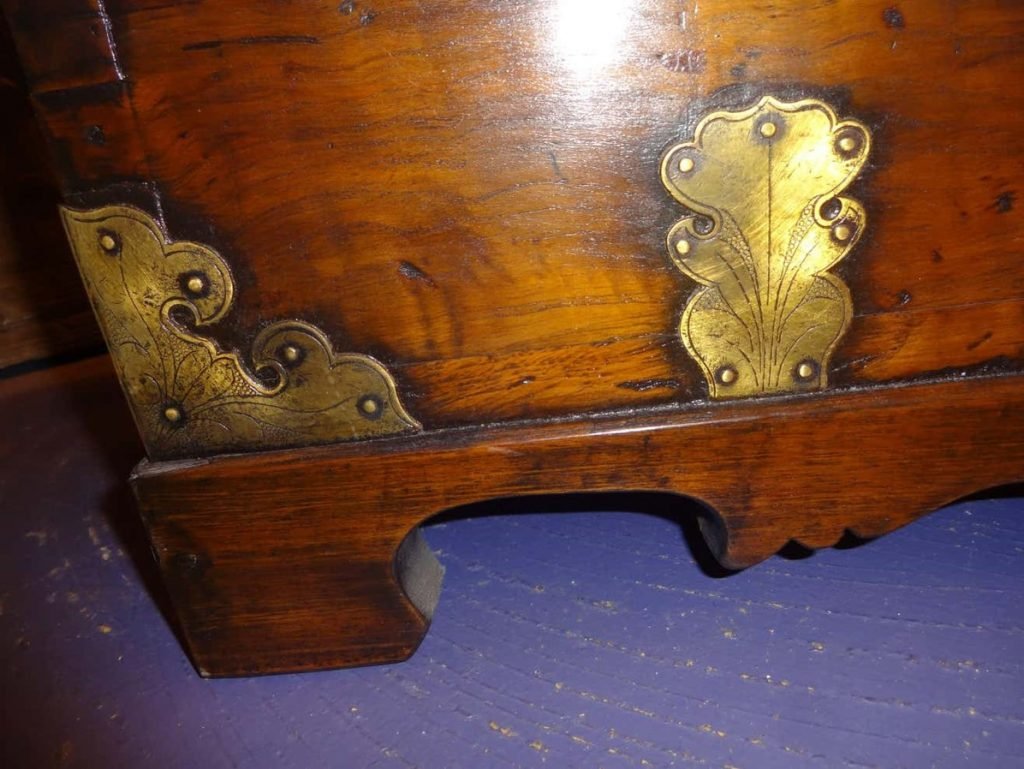
Right: Flower pattern
decorative plate
Metal plates are attached to the corners to protect it from damage.
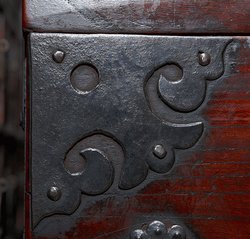
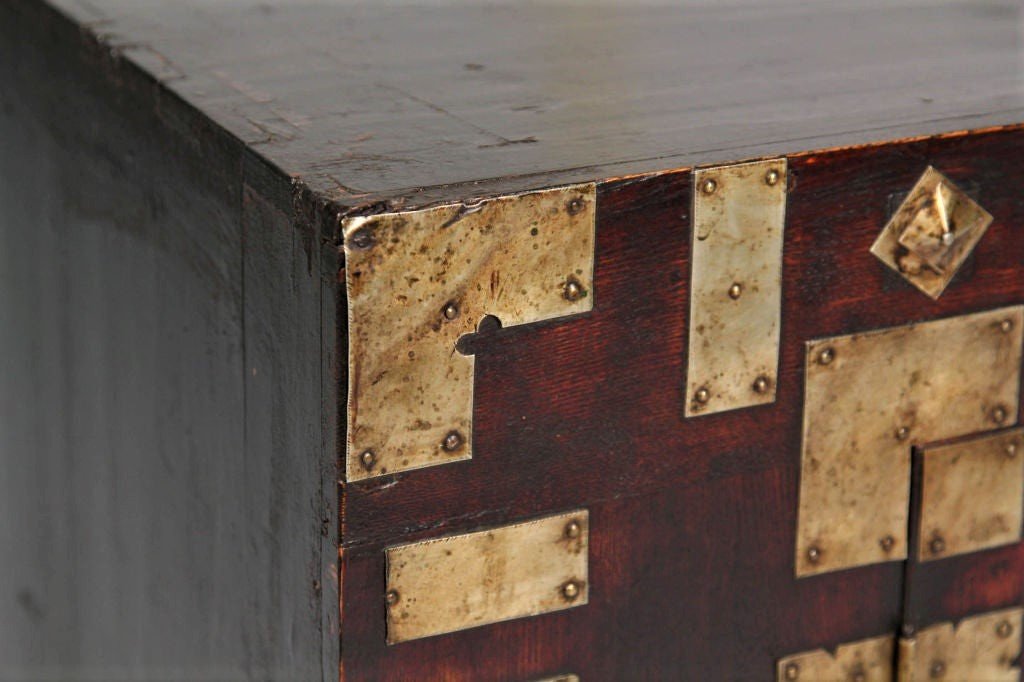
On a Pyongyang Nong from Pyongan Do province ( North ).
CENTRAL DECORATIVE PLATES
A metal plate of a different shape is attached to the middle top or bottom of the front chest to give accent to the piece, serving a purely decorative purpose.
Central decorative plates called “Kwangdujong” were widely used on bandaji. Sometimes, they were used to attach handles to facilitate lifting.
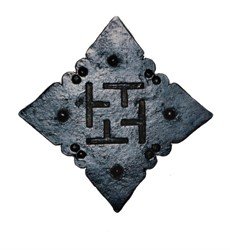
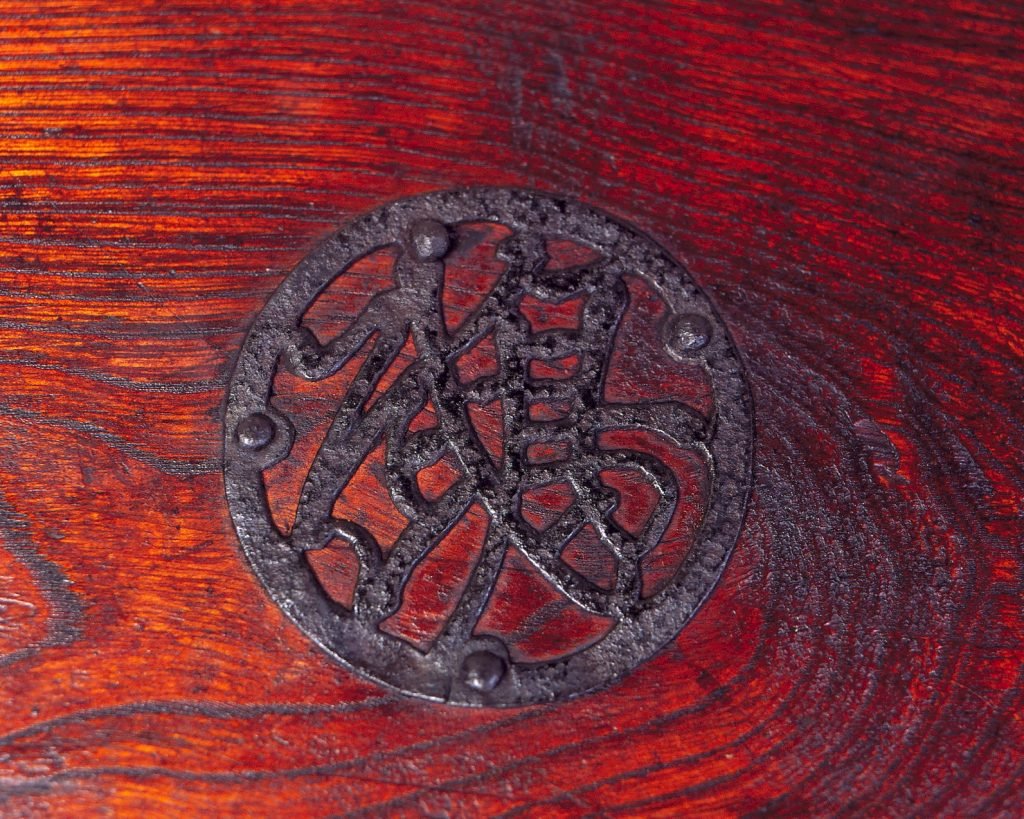

FISH & BIRD PATTERNS.
White brass sea bream also called the “crucian carp” on Bandaji from the northern provinces. Usually located at the bottom of the chest as a decorative purpose..
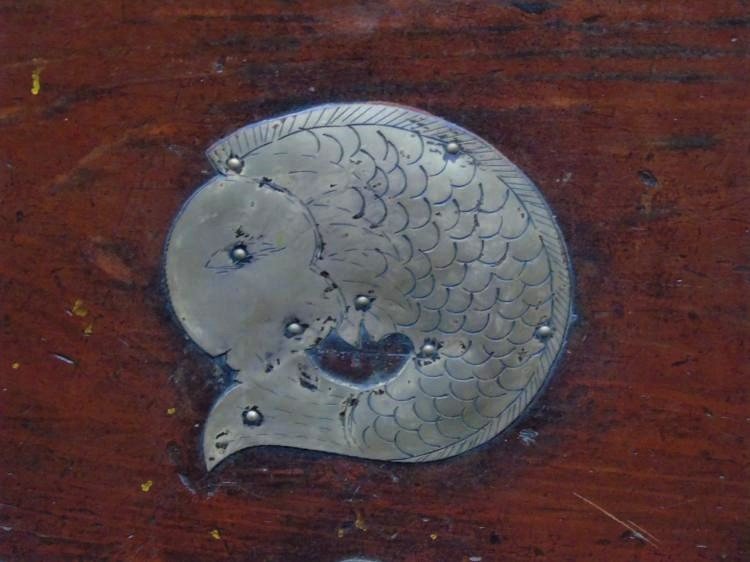
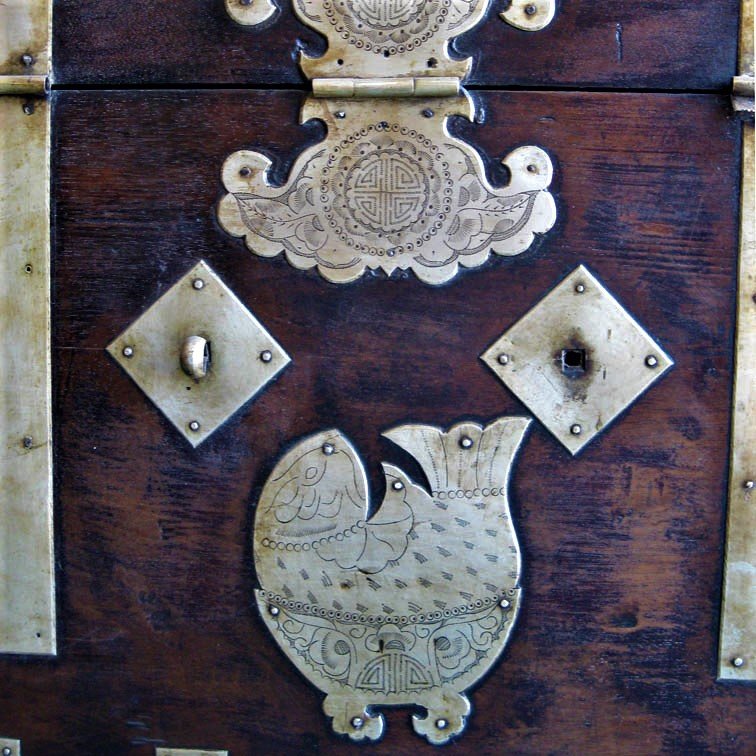

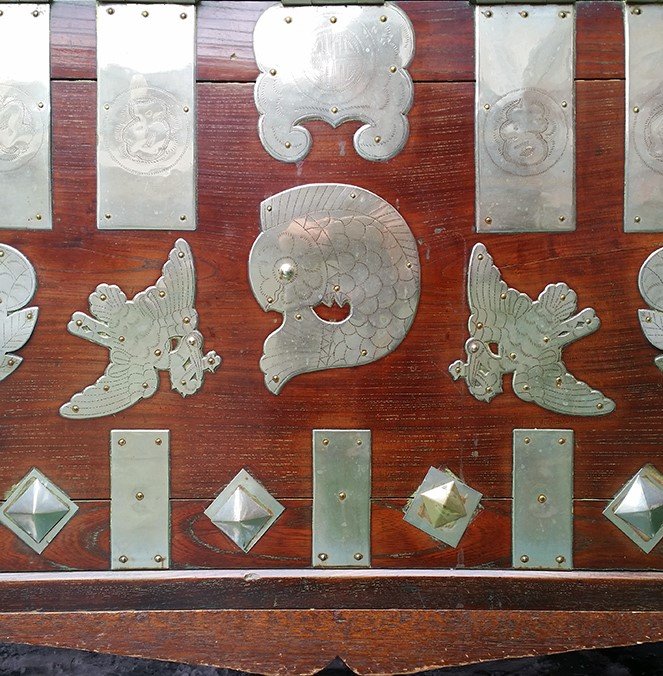

Jeolla Do province.

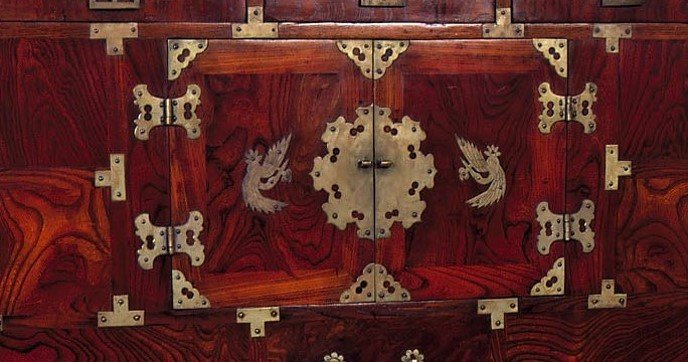
DECORATIVE NAILS

a treasure bead that expresses mysticism and strangeness in
Buddhism.


A typical feature on Jeju Do
Bandaji

CHINESE CHARACTERS & AUSPICIOUS MOTIFS



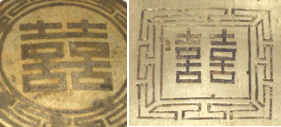


“TAEGEUK” and “MANJA” motifs.
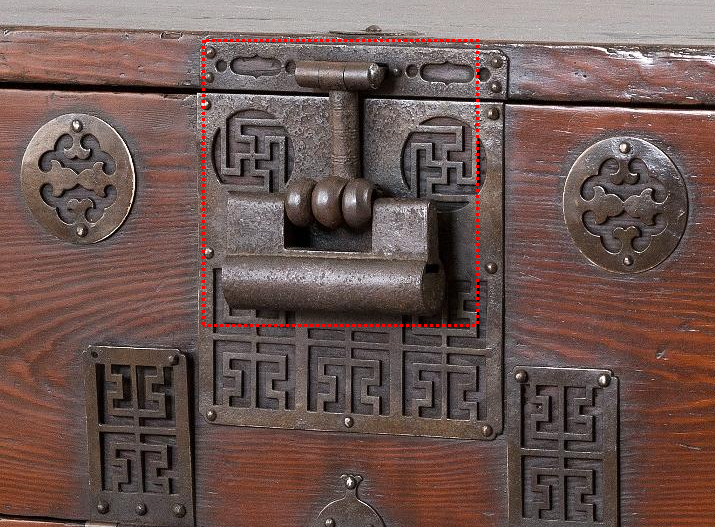




The “RUYI” motif.
Ruyi 如意 is a Chinese curved decorative object that serves as either a ceremonial scepter in Chinese Buddhism or a talisman symbolizing power and good fortune in Chinese folklore. The “Ruyi” image frequently appears as a motif in Asian art, especially on Buddhism-related items such as shrines or low desks used by monks. Seldom used in metalwork, this motif was mainly engraved on wood.
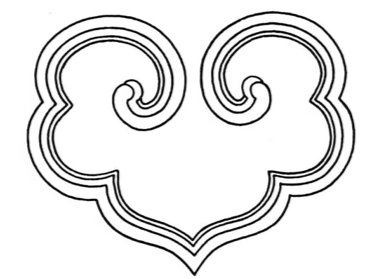
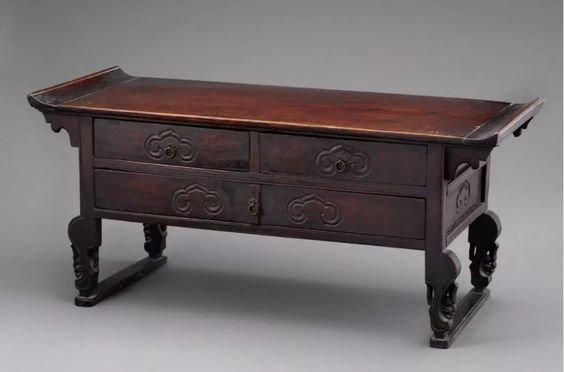
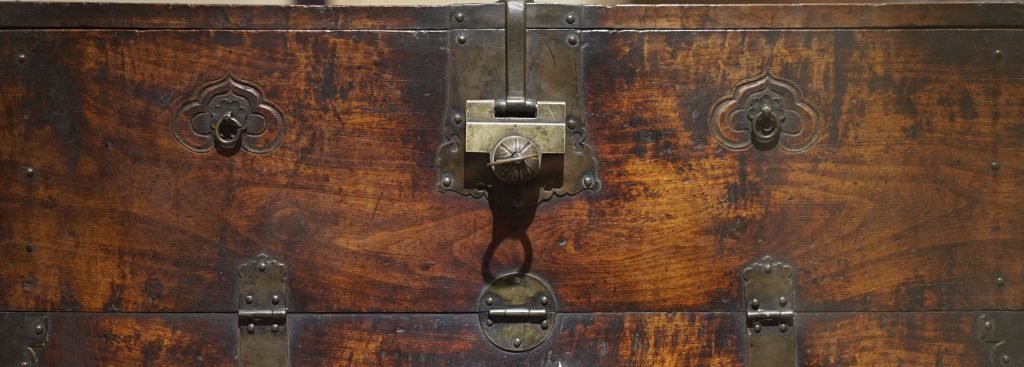
The “EIGHT TRIGRAMS” motif.




on each side of the upper lock plate as well as a multitude
of “Manja” (卍) motifs in openwork on the hinges, corner plates
and central decorative plate.
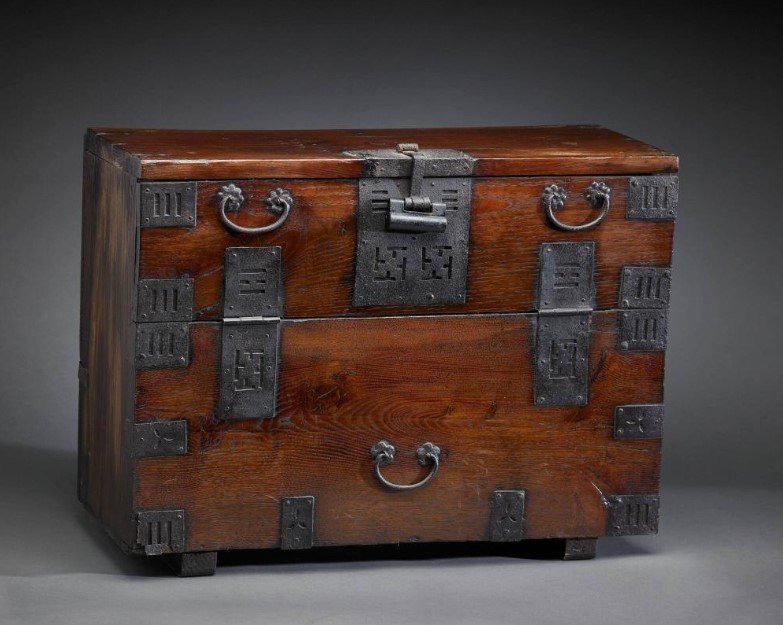
The metal work on this bandaji from the collection of the Harn Museum of Art in Florida USA is a perfect example of this type of motifs. This chest is dated Late 19th to early 20th century. Wood which is not mentioned is red pine.
The central lock plate is incised with two “Heaven” motifs on top of two “Manja” motifs. Corners plates are also pieced with the “Heaven” motif. Long central rectangular plates are decorated with “Fire” motifs (top) and again “Manja” motifs at the bottom.
This type of patterns was mainly used in men’s quarter by educated nobles.


Well done documentation, Yves!
Thank you. Appreciated.
Very thorough and very interesting, congratulations on your hard work.
Thank you.
Bonjour Yves, Merci pour cette présentation de meubles Coréen j’ai beaucoup appris sur ces jolis meubles. Nous avons acheté un bandaji en juillet dernier, auquel il manque une poignée,(c curve handle) c’est en cherchant sur internet que j’ai vu votre site complet et très intéressant. Félicitations et bonne journée.
Envoyez moi une photo de cette poignee manquante. On ne sait jamais.
[…] a previous publication METALWORK PATTERNS ON KOREAN FURNITURE, we listed the various decorative motifs on the hinges of Korean furniture. Below, we examine their […]